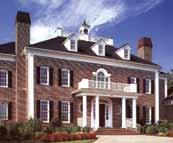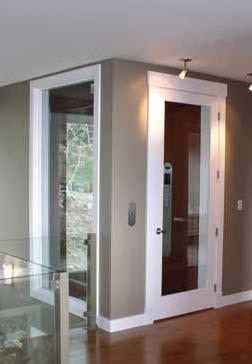































































































Smart, efficient and user-friendly.
All standard features of a Lifebreath ® control.
Compact and stylish, our lifestyle controls put multi-mode and 5-speed programming right at your fingertips. Their intuitive operation optimizes the performance of your Lifebreath ® HRV and other integrated equipment, maximizing the air quality in your home or business while saving energy.
Setting a new standard for energy efficient, clean air homes Visit us at www.lifebreath.com
Make Your Home an Oasis with the Executive Screen
The Executive Screen by Phantom is a unique line of screening and shading solutions designed to enhance the all-around enjoyment of your home.It fits most standard and oversized applications and it can supply shade from the sun,protection from pests,complete ventilation,and enhanced privacy – all at the touch of a button.
Discover how the Executive Screen can shield your porch,convert your garage or shade your picture window.
The Retractable Power Screen Solution
Visit us at www.executivescreens.com or call Ontario Screen Systems at 1-888-742-6866
Seeing is Believing

The official publication of the Ontario Home Builders’ Association Fall 2010
editor
Steve McNeill, ext. 251 steve@laureloakmarketing.ca
associate editor
Norma Kimmins, OHBA
art director
Erik Mohr
copy editor
Barbara Chambers
contributors
Pat Brennan, Brian Burton, Avi Friedman, Shane Gallagher, John Godden, Norma Kimmins, Gillian Lind, Steve Maxwell, Tim Ng, Dan O’Reilly, Scott Reid, Bob Ridley, David Shubs, Randy Threndyle
photographers
Tania Janthur
publisher
Wayne Narciso, ext. 240
associate publisher
Shana Evans, ext. 250
advertising sales
Mary Denyes, ext. 232
accounting manager
Debbie Milner, ext. 243
published by

Laurel Oak Marketing Ltd. www.ohba.ca info@ohba.ca
Ontario Home Builder is published six times per year (Spring, Trends, Summer, Fall, Awards, Winter). All rights reserved. No part of this magazine may be reproduced without the written consent of the publisher © 2010. Single copy price is $4.00. Subscription Rates: Canada $11.95 + HST per year, USA $29.95 USD. Mail payment to:
Laurel Oak Marketing, 1062 Cooke Blvd., Burlington, ON L7T 4A8 Phone (905) 333-9432 Fax (905) 333-4001

CANADIAN PUBLICATION MAIL AGREEMENT NO. 42011539 ISSN 1182-1345






One faucet. One diamOnd™ valve. five milliOn uses.
DIAMOND™ Seal Technology. Want to know the secret to a long life? for faucets, it’s diamOnd seal technology that combines a durable diamOnd valve with innoflex™ PeX waterways. the diamOnd valve features a disc embedded with real diamonds to last up to ten times longer than the industry standard* and the threat of leaks is all but eliminated, thanks to the one-piece innoflex PeX supply lines. Once inside the faucet, water is not in contact with metal contaminants. no leaks. no worries. another way that delta is more than just a faucet.
diamondsealtechnology.com

By James Bazely
It is with mixed emotions that I write my final One Voice column as OHBA President. A Past President once said that the most fundamental measure of success is to leave the association in better shape than when I started. While the economy isn’t something to write home about, it does appear to be slowly picking up. OHBA has also made progress on a number of government relations and Tarion issues, while other issues such as inclusionary zoning and the impact of the HST on the underground economy still require attention. I’m also very proud to have assisted in revitalizing and renewing the annual Builders’ Forum with a fresh new location and program - I hope to see many of you again at Blue Mountain in Collingwood this February.
Looking forward to 2011, I don’t quite yet plan to ride into the sunset. As Canadians, we sometimes don’t realize how lucky we are to live and conduct business in this part of the world and as an association, we have considerable expertise when it


comes to providing shelter. That’s why in 2011, OHBA plans to lead a very special humanitarian build in combination with our annual conference to make a real difference in improving the quality of lives for a community of marginalized persons in the Dominican Republic. I believe participants in this endeavour will come home reinvigorated, thankful and inspired. I know my daughter who is currently involved with an international development organization has inspired me.
Here’s an excerpt from her blog that may motivate you to participate next year:
“I first fell in love with the Dominican because of the love and affection from the kids; they won over my heart. One little girl in particular really made me want to cry today; she is eight years old, and I was sitting in a chair when she came over for a hug. She smelled not so clean, and really just wanted to sit there with me and cuddle. And even though she does this quite often, I couldn’t help but tear up thinking about how much she really needed this…. It wasn’t until
if you participate in this endeavour you’ll come home reinvigorated and inspired to do more in your community.
I started coming to the Dominican, that I realized love and affection is just as much something to be thankful for as food and water.”
The 2011 OHBA conference is being co-chaired by OHBA Past President Danny Gabriele and me and we hope that we will have your strong support in this unique endeavour.
Thank you to the 4,000 OHBA members, the OHBA Board and my local association in Simcoe County for entrusting me to lead this outstanding organization. OHB











As anyone who has ever attended an OHBA conference can attest to – these events are about much more than just business…although that’s always high on the agenda as well. But it’s also about fun, networking and enjoying the uniqueness of the community you are visiting. So expect to have an entertaining and informative time at the 2010 OHBA Annual Conference in Windsor with your hosts, the Greater Windsor HBA who will begin by welcoming you to a fantastic end-of-summer beach party at the opening reception and BBQ.






A number of OHBA Past Presidents and OHBA staff recently joined Pat White as she celebrated 20 years of service with the organization. White joined the OHBA staff on Aug. 1, 1990 and in addition to her numerous administrative duties, has been the welcoming face and voice at OHBA’s reception for two decades. Her commitment to the organization is outstanding and her kind and helpful approach is most appreciated by members and fellow staff members. OHBA wishes Pat White much happiness and continued success.








But the fun doesn’t end there! Go “clubbing” –whether at the Ambassador Golf Club for a round of golf or the Canadian Club Brand Centre for a tour and tasting. Or island-hop along with the Hon. Jim Bradley, Minister of Municipal Affairs and Housing, for an enjoyable housing tour on Bob-Lo Island. In between, enjoy a stellar line-up of impressive speakers covering a range of topics including green building, Ontario’s political and economic outlook, building healthy communities and retrofitting older homes. Top it all off with the exciting Awards of Distinction for an unforgettable conference! Register online at www.ohba.ca.



Canada Mortgage and Housing Corporation (CMHC) is presenting five Housing Outlook conferences or seminars to provide timely and reliable forecasts and analyses designed to assist you in making informed decisions for your business. The 2010 events will provide leading-edge expertise on local housing market trends in your community. To register, call 1-800-668-2642 or online at www.chmc.ca


Kitchener (seminar) november 2
toronto (conference) november 3
hamilton (seminar) november 10
ottawa (conference) november 16
london (seminar) november 18


OHBA President James Bazely welcomed the Honourable Peter fonseca, Ontario Minister of labour to the grand opening of Gregor Homes Pineview Estates in Midland – a Energy Star and GreenHouse community where they also discussed issues of concern to the residential construction industry.


Members of OHBA have donated close to $9,000 for Haitian relief to Absolute leadership Development Inc. who are delivering aid to the earthquake ravaged country. Aid, including medical supplies, food, water, clothing and tents were distributed to two different tent towns, an orphanage and a displacement camp. Christal Earle, co-founder of Absolute will be speaking at OHBA’s conference in Windsor to inspire, prepare and motivate delegates to participate in OHBA’s 2011 Humanitarian Build and Conference in the Caribbean.

Minister fonseca launched a highprofile advertising campaign in communities across Ontario this summer sponsored by the MOl, the Workplace Safety and Insurance Board and the Infrastructure Health and Safety Association, to promote awareness in construction safety. Ontario has one of the lowest rates of lost-time injuries in Canada, 1.37 per 100 workers, but fonseca still wants to see improvement. After a three-month check of more than 2,800 construction projects the Ministry found many violations related to missing or inappropriate use of guardrails, scaffolding and fall-protection systems so they are providing safety tips concerning fall prevention in print on construction sites and on their website at www.ontario.ca/ ConstructionSafety

The Hamilton-Halton HBA, under the leadership of lead contractor Jeff Paikin (New Horizon Homes) and co-chair of the Wellwood Building Campaign Aldo DeSantis (Multi-Area Developments) were major contributors to the construction of a new cancer wellness centre in Hamilton.

Through various fundraising initiatives and by providing in-kind donations of materials and labour, Hamilton-Halton HBA member companies stepped forward to help in the effort that began in 2007 and recently culminated in the official opening of the facility.
Hamilton-Halton HBA representatives joined dignitaries and elected officials, Wellwood staff and board members, generous donors, volunteers and curious neighbours at the

Wellwood is a local charity dedicated to helping cancer patients, their families, caregivers and health care providers to “live well” with cancer. The Centre offers about 25 different services, and there are almost 250 active trained volunteers involved in the design and delivery of programs – all free of charge.







Nothing sells a home faster than adding cost-effective, energy-efficient insulation and weatherization products. That’s what you get when you add Dow Building Solutions to your team. Our broad portfolio of energy-efficient sheathing, housewraps, spray foam insulation and accessories is backed by 65+ years of building science experience and industry knowledge. It’s building performance you can measure – in lower utility bills for homeowners, fewer call backs and increased referrals.
Find out how Dow Building Solutions can help you reach your goal for long-lasting energy efficiency at www.insulateyourhome.ca or call 1-866-583-BLUE (2583).

www.insulateyourhome.ca


The finalists for the 2010 Awards of Distinction have been selected and winners will be announced on September 21 at OHBA’s Annual Conference at Caesars in Windsor. Register now…you won’t want to miss the awards gala! Here are a few of this year’s finalists from some of the 33 categories of design, sales and marketing:
utstanding Production built home
(One storey up to 1900 sq. ft.)
b K cornerstone design build ltd. for: forest Hill Estates“forest Hill Ranch” lakeshore
(CREDIT TO: DESIGnWORkS CABInETRy)
rinaldi homes for: Coyle Creek Estates -
“The Winterbury” Welland
starward homes for: kitty Murray Woods
“The filman”, Ancaster most outstanding Production built home
(Two storey up to 2500 sq. ft.)
devonleigh homes for: Parkside “Monterey”, Alliston reid’s heritage homes for: Cobble Beach
“The Elderslie”, kemble
(CREDIT TO: MOnTAnA STEElE
ADvERTISInG; GuTHRIE MuSCOvITCH; PRyDE, SCHROPP MCCOMBS InC.; MDP lAnDSCAPE) schuit homes for: Pleasant valley Estates - “The McGrath” Dundas
most outstanding custom home
(5000 sq. ft. and over)
ambassador fine custom homes inc. for: “Saxony Manor” Mississauga
(CREDIT TO: MICHAl J. CERny)
christopher simmonds architect inc. for: “Waters Edge Home” - Missisauga
(CREDIT TO: 2H InTERIOR DESIGn)
rawlings homes for: “Goh Chan” london
most outstanding attached multi-unit home
(semi/town home/ stacked)
fusion homes for: Privada - “Palazzo” Guelph
Phelps homes ltd. for: The Residences at Jordan village“voronoff” lincoln
Queenscorp group for: The Harbour Club “vineyard Sound” Oakville
most outstanding high rise condo suite
aspen ridge homes for: 77 Charles Street West - “Suite no. 3”
Toronto
(CREDIT TO: HOk ARCHITECTS)
monarch corporation for: Couture - “london 977” - Toronto
(CREDIT TO: GRAzIAnI & CORAzzA ARCHITECTS InC. )
monarch corporation for: Waterscapes “PH01” - Etobicoke
(CREDIT TO: GRAzIAnI & CORAzzA ARCHITECTS InC.)
most outstanding home renovation (over $500,000)
a lifetime contractor for: “lake view by the Promenade” Toronto
(CREDIT TO: AnTOnEllA fERROnEWIlD Of “fOuR WAllS AnD A ROOf”)
northern edge construction services ltd. for: “Guildcrest Drive”Scarborough w.c meek design & construction ltd. for: “Toronto Beaches Home Renovation”Toronto

best new home sales office
(under 1500 sq. ft.)
devonleigh homes for: “Parkside”Alliston
(CREDIT TO: ADvAnTAGE STAGInG; MICHEllE fInnAMORE lAWlOR & COMPAny MARkETInG & COMMunICATIOnS lTD.) landmart homes for: “Cherrywood Estates” - Grimsby mason homes for: “JuST 4u”Barrie
(CREDIT TO: BAM BuIlDER ADvERTISInG & MARkETInG InC.)
HIGH RISE
fram building group for: “REflECTIOnS Residences at Don Mills” - Toronto
(CREDIT TO: THE BRAnD fACTORy; RAW DESIGn; MIkE nIvEn InTERIOR DESIGn )
liberty development for: “World Condos at World on yonge” Thornhill
(CREDIT TO: kIRkOR ARCHITECTS AnD PlAnnERS; HEfElE MAkOWkA DESIGn ASSOCIATES; MOnTAnA STEElE ADvERTISInG; BRAnDOn COMMunICATIOnS) tridel for: “Reve” - Toronto
(CREDIT TO: THE BRAnD fACTORy)
lOW RISE
hush for: “Avalon & The Gardens At Coronation” Oakville
(CREDIT TO: HICkS PARTnERSHIP ARCHITECTuRE; vAnDER BRAnD)
reid’s heritage homes for: “Cobble Beach” kemble
(CREDIT TO: MOnTAnA STEElE ADvERTISInG; GuTHRIE MuSCOvITCH; PRyDE, SCHROPP, MCCOMBS InC.; MDP lAnDSCAPE)
reid’s heritage homes for: “lora Bay” Thornbury
(CREDIT TO: MOnTAnA STEElE ADvERTISInG; lISA ROuGHly – InTERIOR DESIGn; EnvISIOn; THATEM & IRWIn fOSTER - lAnDSCAPInG )
best internet web-site (Builder or Renovator) fusion homes for: www.fusionhomes. com
Preston group for: www.bladecondos. com
(CREDIT TO: G. RyAn DESIGn )
reid’s heritage homes for: www.heritagelakeestates.com

(CREDIT TO: MOnTAnA STEElE ADvERTISInG ) ontario green builder of the Year mason homes Concord minto group Toronto / Ottawa reid’s heritage homes Cambridge



Nes venimusam simporatur audae corias aut modis molorit rento consendant moditia sperspis magnis conseca eperor ape iunti dundem etur res maxim nusdaec esenimusdam nullam iust, comnis aut que doluptatem rem quo officat ut enimus modit, omnisque dipsant pro omniminis nat volentus eos eatium et es ped explis dolupta eperesed moditium voloressimi, veristruntus eumquam, aut eatiur acidis estem evel ipisqui atiatis de volore quidunt voloresto.





Just as new home designs change to meet new demands and consumer trends, it was time to shake up Ontario Home Builder to give the magazine a new contemporary and dynamic look. Readers today tend to be scanners, having been influenced by how information is delivered on the Internet – their attention is drawn to brightly coded nuggets of information along with shorter, more informative stories.
Our presentation is bolder, easier to read and scan, and reflective of the direction many of the more popular and progressive magazines are heading. In our redesign, we’ve also identified key subject areas that will always have a high interest to builders and we have positioned them as standing columns – Money Matters, Human Capital, Marketing and Outside the Box by Avi friedman.
for more detail about the redesign








Two Quinte home builders, Staikos Homes and Geertsma Homes along with their trades and suppliers joined together with the Quinte Home Builders’ Association and launched the Home Build for Health Care campaign.
They’ve begun construction of two houses (which they hoped to have completed by September) that will be sold with proceeds donated to Quinte Health Care for the purchase of priority medical equipment at the Belleville and Trenton Hospital sites. Organizers hope to raise as much as $500,000 for the cause.
Mary Clare Egberts, Quinte Health Care CEO said, “In my 20 years in the health care, this is the most innovative fundraising project I have seen.” Both builders have been blogging about their builds and you can access blog updates at: www.homebuildforhealthcare.blogspot.com













Two prominent Ontario builders have stepped up to the plate to help raise funds for the Toronto Sick Kids new Research and Learning Tower. Freddy DeGasperis Jr., Vice-President of Aspen Ridge Homes, and Peter Gilgan, President of Mattamy Homes, are members of a 35-member, high-profile cabinet charged with raising $200 million over the next three years. A total of $100 million will be directed to the $400 million construction costs of the Tower with $100 million directed to the creation of an endowment fund which will support the ongoing operating costs of the building when it is completed in 2013.
The 21-storey, 750,000 square foot Research & Learning Tower is under construction at the corner of Bay and Elm Streets and will bring together the 2,000 scientists and staff of SickKids Research Institute. Designed by Diamond and Schmitt Architects Inc. with HDR Inc., the world-class facility will achieve LEED Gold Certification – setting the standard for energy efficiency and sustainable infrastructure in Toronto’s Discovery District.
The building will showcase the incredible depth and breadth of research being conducted by the Hospital to improve child health through prevention, better cures and early detection of
childhood disease.
“The magnitude of this project will transform the community’s understanding of SickKids,” said Ted Garrard, President and CEO of the SickKids Foundation. “The Tower will ensure the stature of SickKids as a world leader in children’s health research, education and care.”
To donate to the project visit www.sickkidsfoundation.com/bepartofit/.





























How Reid’s Heritage Homes survived the death of its founder
By Scott Reid
Scott Reid was only 21 when his father Orin died just weeks after he came down with what he thought was the flu. When Scott looks back on that day 10 years ago, he wonders how the family and the business, Reid’s Heritage Homes, survived.
We were with Dad at the Cleveland Clinic in Ohio. It was Saturday and the doctors were confident he would pull through. What had begun as symptoms of flu turned out to be leukemia. His doctor suggested tests on Wednesday and here he was just a few days later in Ohio, fighting for his life.
By Sunday morning Dad was signing power of attorney over to my brother-in-law Tim Blevin and me.
A few hours later he died in surgery. He was only 48 and left a wife, four children and a successful business.
To say it was an incredibly painful
and troubling time is an understatement. We were all busy grieving, and yet we had a multi-million dollar business with no one at the helm. Thankfully Tim really stepped up and carried the weight in keeping the business moving forward. We were also fortunate to have an incredible staff that made the transition easier.
I have to chuckle today when I think what a sight Tim and I must have been to the staff. Here was Tim at 26 and me at 21 reassuring employees that everything would be okay – that we didn’t know how it would evolve, but to trust us.
It required a lot of perseverance and as difficult a time as that was, we had no other choice.
Our advantage was that we all had experience in the industry. Dad had been a tremendous mentor and helped Tim and my sister Charlotte and me set up our own companies in order that we would find our own way in the industry. I had already worked for Dad while in high school and had my own company when I left school. These were boom years. Dad’s business was growing. I was building 75 to 100 homes a year under Brooklyn Homes and Tim and Charlotte were doing similar volumes in Collingwood as Sherwood Homes. Our companies still exist for warrant issues and other obligations, but they essentially became dormant when Dad died.
How we sorted out each of our roles, we simply sat down and determined our strengths and how we would best serve the company. Tim was strong in business, finance and land development and so he was the obvious choice to take over as President. My strength was on the operations side and so Vice-President of Residential Construction suited me just fine.
We’ve ended up in positions in which we are comfortable, but there is still an informality about the operation. We deal with problems collectively. If I want to talk to Tim about something, I simply walk next door to his office.
I was very very young and very green, and perhaps one of the biggest helping hands I received was from Dick Brouwer, a partner with Zebro Development in London, who encouraged me to sit on the OHBA’s Tarion Liaison Committee. It forced me to get out there, to see what other successful builders were doing. I learned so much and made so many valuable connections.
What I also learned was the importance of putting some estate or succession planning into your business. When you are involved as a family, it should be an annual check up. You don’t need to go into great detail, but it is healthy to have some type of vision – even verbally.
What happens to the business will have an enormous impact on my wife Shelley and my three young children. So, I’m really open about the business with Shelley. She knows what I’m up to and into and what I’m thinking. It’s happened once in my lifetime; I don’t what to put my family through that.
And my mother, who started the business with my father in 1978, still comes into the office on a regular basis to keep an eye on us. OHB


with aDhoc. reached at tng@adhocimc.ca. Ng is with He be
By Tim Ng
One could argue that the true measure of a development project stretches far beyond the mere dimensions, blueprints and rhetoric of a construction plan. Instead, it lies in the ability to obtain as well as share a vision of what it would physically be like to set foot in a structure enclosed by welcoming walls and a sturdy roof.
This is especially true when buying a pre-construction home. It begs the question, how might a consumer truly commit to a home which they cannot see? How might a developer convey such an intangible vision for which no tangible structure exists?
Model homes are perhaps the most tactile option in showcase capabilities and even now, remain the zenith of design. However, they are much too costly for large endeavours, inherently prone to delay and ultimately limit accessibility for a potential buyer. In the age of computergenerated imagery and digital media, harnessing the resources necessary to provide
a virtual tour are no more challenging than recreating the latestbvideo game. It should come as no surprise then, that increasingly developers are looking towards the expertise of visualization firms to better address their business needs.
Digital animation has been around for years, but it has
play streetscapes, amenities, feature dedicated green spaces and ponds. It is 3D virtual tours that allow a buyer to view their home and the community as if it were built.
Computer renderings can now add value to a diverse stream of outlets ranging from websites, mobile devices,
3d manipulation is allowing for an unprecedented amount of flexibility without running the risk of breaking the bank.
finally matured to the point where it’s cost-effective for builders to use it. Whether utilized to underscore the grandiose of a high-rise or the simplicity of a low-rise project, virtual tours represent an aesthetically dynamic means to complement model suites, showcase communities, dis -
social media sites, LCD TVs, and touchscreen displays to QR Codes and DVDs. Amidst all the revision, however, one constant remains – enabling a buyer timely and comprehensive access to the information they desire inevitably accelerates the sales process.
For developers, such 3D
manipulation is allowing for an unprecedented amount of flexibility without running the risk of breaking the bank. Remarkably, technology has come down in pricing and it can be widely used on every single development project. It is infusing excitement into the sales experience as well as providing developers and sales representatives with a larger window of opportunity to engage their clients at their sales centres.
Virtual tours are also ushering in a new movement of digital display whose popularity is spreading through various platforms. We’re at the developing stages of creating real 3D content with our virtual tours where the images would pop off the screen. These would be similar to theatre calibre 3D films like Avatar.
It would appear that the evolution of not only the consumer, but the entire climate of technology is a telling sign that there is room for developers to draw from a resource which many have yet to fully tap into. OHB


to attract and keep the best
By BoB Ridley
There has been much recent discussion concerning the proposed new College of Trades that, depending upon your perspective, will hopefully promote entry into careers in skilled trades and modernize the skilled trade system (i.e. the apprenticeship system).
Many of the business issues surrounding skilled workers come down to availability and cost. The availability of skilled workers is critical to the success of a residential home builder.
Availability is primarily constrained by the extent to which labour is organized and the extent to which the labour force can be expanded. In addition, there are the traditional business issues of cost, customer service and build quality, all of which are heavily affected by worker skill levels.
According to a recent Construction Sector Council report Construction Looking Forward 2010 – 2018 Key Highlights, the job losses
resulting from the economic downturn will be largely made up by the end of 2011. Thereafter the labour market will continue to tighten as a result of increased demand for skilled workers and relatively limited supply.
In fact, it is estimated that
Identifying potential skilled workers will place greater demands on the human resources function for most builders.
The past approaches of identifying potential workers by asking around, posting “help wanted” signs or simple
many of the business issues surrounding skilled workers come down to availability and cost.
the shortfall in construction sector workers could amount to 100,000 people as retirements diminish the workforce. In addition to this shortfall, it is also very likely that the increased sophistication of the new residential products will result in greater expectations for skilled workers.
advertisements will not suffice. Identifying new workers will increasingly rely on approaches such as job board websites, social media and networking and, especially, involvement with school programs.
Recruiting these workers once identified will likewise
place greater demands upon the availability of competitive compensation and benefits programs. Many of these programs will require a new mindset when it comes to perks and other job incentives.
The following tips will help to identify, recruit and retain the skilled workers critical to your business success:
• Be conscious of your brand and your image as an employer.
• Be imaginative when looking for ways to identify new skilled workers and consider associating with schools.
• Offer compensation and benefits programs that are attractive and are reflective of the wants of those you hope to hire.
• Offer training and development for your current employees and ensure that the benefits are mutual.
• Offer performance management programs for both your staff and your trade partners. OHB

TK tk tk tkt tk tk tk tk tk
By DaviD ShuBS
The Canadian economy looks to be stabilizing, with Canadian businesses having a generally positive yet cautious outlook. Since July 2009 over 400,000 jobs have been created and the unemployment rate has dropped to under 8 percent. Firms are currently reporting sales growth and are expecting this trend to continue over the next 12 months. Businesses are reporting that they are reaching capacity points and therefore anticipate hiring new employees.
Based on this growth and the future outlook for the Canadian economy, the Bank of Canada has raised interest rates 0.75 percent since the summer. However, the Bank understands the delicate nature of this recovery and has accordingly reduced its outlook for future growth.
In the long run, the new financial discipline displayed by both consumer and government, should lead to a more stable economy. However,
the short term will likely be defined by volatile markets and shaky consumer confidence.
In times of uncertainty, a financial blueprint provides the best defense. Asking and
ment strategy can then be created.
The basis behind any investment portfolio is a risk/return trade-off. Higher desired returns require higher risk investments. Similarly, lower risk investments generally
answering the hard questions:
• What do you want from your money? How do you want to spend your time? What is the legacy that you want to leave?
• provides a glimpse into the future, regarding where you want to be and when. Once you set these goal posts, a financial plan and invest -
provide lower returns. Working with set goals can allow a risk/return metric to be established. This will direct a portfolio and allow for an appropriate asset allocation. Asset Allocation is the manner in which an investor distributes their portfolio between different asset classes (stocks, bonds, alternative assets and
cash) and accounts for up to 93 percent of portfolio returns. In normal circumstances, different asset classes behave differently to the same situations. For example, an increase in interest rates will decrease the value of a bond, but may have a positive impact on stocks. The goal of asset allocation is to choose assets that perform differently to the same situation, thereby reducing a portfolio’s overall volatility. This can be done by holding the proper combination of instruments which are not perfectly positively correlated. This diversification should achieve the same portfolio return with reduced risk.
Properly managing a portfolio requires homework. While there is no hard and fast rule about how much research needs to be done an individual investment, it has been recommended that at least one hour per week should be dedi-




At Reliance Home Comfort,™ we’re always working to keep our Builder Program at the forefront of the industry. And our new Comfort Value Bundles are no exception.
Save up to $6,000 in capital costs per house
The bundles bring together some of our best-in-class heating, cooling and air filtration products along with the water heater rental equipment Reliance is so well known for. The result: bundled products that benefit both builders and homebuyers.
What’s in it for you?
• Up to $6,000 in savings per house – Reliance covers the capital costs of any bundled equipment
• More installation allowances – the bigger the bundle, the more allowances you will receive
• No post-sale equipment service costs – we take care of any repairs on rental equipment
What’s in it for your homebuyers?
• Peace of mind – all repairs, parts, labour and replacement costs are included for life*
• Live telephone support – 24/7/365
• Ease of renting – predictable monthly payments
Make Comfort Value Bundles a standard in all your new builds. Call 1-888-499-7255 or talk to your Reliance Key Account Manager today.





When
When
When




as your








With the constant demand to be as productive as possible on the jobsite tradepeople can’t waste valuable time searching for misplaced tool parts. Constructed with highly resistant material, the magnetic and compact Toughcase from DeWalt eliminates those timeconsuming searches. It conveniently fits into users’ pockets or pouches, making it easily accessible at all times. Yet it’s large enough to hold common accessories including 6” SDS+ and drill bits, 1-3/8” step bits and 1-1/8” hole saws. Another handy feature is two magnets on the lid which allow tradespeople to attach the container to any ferrous material such as HVAC ductwork, steel studs and job boxes. Built-in hooks at the back of the case also make it easy to hang as well. www.dewalt.com
Bring Back a Brick








geTTing The upper hand
Cambridge Elevating announces its Heritage model, the next generation of home elevators. The Heritage allows you to retain the traditional look of the home by having a swing door on the landing, plus a set of automatic sliding doors that travel with the cab. With numerous finish options, the elevator can blend seamlessly into the home’s décor. Whether the homeowner wants to access all levels of their home, or to add the convenience of a home elevator, Cambridge Elevating has several custom solutions. www.cambridgeelevating.com
Bridging The gap
Robins Appleby & Taub LLP’s BRIDGE Group is a team of legal professionals who can move projects forward. When the needs of builders and lenders don’t match up, the team bridges the gap with new ideas, relationships and financing sources. It has the expertise to guide complex commercial and residential developments through construction, financing and sale with a particular focus on condominiums. www.robinsapplebyandtaub.com/bridge
Hanson Brick is bringing its vision of building on the past, restoring the balance and creating the future to life by introducing the Brick Back Program at its Ontario facilities. In effort to reduce on-site construction waste and the resulting burial in landfills, the free program accepts “clean” brick waste to be converted into ground, recyclable material for addition to Hanson Brick’s existing products. The Brick Back Program can also help contribute to LEED credits under MR credit 2.1 and 2.2 – Construction Waste Management. www.hansonbrick.com



innovaTive insurance soluTions
As costs continue to rise and builder’s margins continue to shrink, today’s new home builders are looking for alternative means to minimize their costs. Home Builders Insurance Group (HBIG), a member of the Jones DesLauriers group of compa nies, is an industry leader in providing cost effec tive and innovative insurance solutions, affording builders and contractors the opportunity to save an average of 20 to 30 percent on their insurance costs. For over 50 years HBIG has been providing insurance solutions from foundation to finish to the residential construction sector. Whether it’s insuring assets and materials, or reviewing surety bonding requirements and contracts, the team at HBIG has the understanding and expertise to manage even the most complex insurance challenges. www. homeBuildersinsurance.ca

help your homeowners geT connecTed Rogers is offering to supply builders with the marketing support they’ll need to make a sale, including signage and collateral. Rogers will also provide approved RG6 co-axial cable that will make your homes ready for digital TV, hi-speed Internet and home phone. Rogers is committed to delivering innovative services and excellent value to your homeowners. Providing your homeowners with an easy and affordable way to get connected as soon as they move in gives you a significant competitive advantage. To learn more about this partnership, contact your regional account executive at 1.877.567.5778 or visit www.rogers.com/cma.
Polycrystalline Diamond (PCD) blade from Irwin Mar athon can help make the job a lot easier. With diamond tipped teeth which can deliver up to 15 times longer life compared to standard carbide tipped blades, it can cut up to 9,000 feet of fiber cement board. The laser cut body also provides a stronger tooth bond and greater cutting accuracy on the jobsite. It also generates less dust. The blades can be found in industrial supply stores across Canada and are available in sizes 7 ¼” 4T; 10” 6T; and 12” 8T. www.irwin.com
Comfort Value Bundles from Reliance Home Comfort promise peace of mind for homebuyers, providing them with service and repairs for the life of their rental water heater, furnace, air conditioner and air handler combo systems. Now the program is catching on with builders who are offering customized programs to their customers. All equipment repairs, parts and labour required are included for the life of the rental equipment. Plus, equipment replacement is available at no cost, should it not be repairable following normal use. www.reliancecomfort.com
sTone venTs seem To disappear With the innovative and custom made StoneVent from Accents of Distinction builders have the ability to finish their floors in a seamless, high quality manner and create a point of difference which will distinguish them from the competition. Fabricated from premium stone, this product will match any tile being considered, provide a smooth transition in balancing any tile or stone flooring and create the impression the air vents have disappeared. Standard sizes are 3” x 10” or 4” x 10” and prices range from $90 to $150. The Mississauga-based custom stone and tile fabricator also produces a specially designed tile that can be rotated on any kitchen back-splash. www.accentsofdistinction.com
























GeoSmart Energy’s Premium Q systems are the geothermal industry leader for energy efficiency, comfort and reliabil ity. The Premium Q is an all-in-one quad system for heating, central air conditioning, hydronic heat (in-floor hydronic and radiant applications) and domestic hot water production in one convenient package. The compact Premium Q can provide energy savings up to 80% compared with ordinary furnaces and air conditioners. For every dollar of electrical energy it uses to run the heat pump, it generates almost five dollars worth of energy output to heat and cool your home, representing an efficiency rating of 500%. www.geosmartenergy.com

geTTing microfiT
DuROCK Alfacing International announces that it has received the first microFIT (Feed in Tariff) payment, demonstrating the benefits of the photovoltaic system project unveiled with SANYO Canada and AVACOS Solar Energy in December. The payment received was approximately $4,000, representing five per cent of the $92,000 installation cost, accounting for a 25 to 30 percent additional power generation from the installation compared to conventional solar rooftop installations. DuROCK Tio-Coat is a high-strength white elastomeric urethane roof coating that provides 89 percent solar radiation reflectivity and weather resistance, reducing the energy usage required for the building compared to traditional roof coverings. www.durock.com

Carrying or lifting material and tools on to new home or condominium construction site can often be a difficult and possibly dangerous operation. Purchasing or renting a ramp to minimize such hazards could be a wise business and construction investment for builders. Residential ramps made by Access Ramp and Mobility Systems are durable, maintenance free, and designed to withstand Canadian winters, says the company. Comprised of a welded aluminium frame and railings, they can be easily moved or relocated. The ramp system is also modular and can be adapted to each location. A number of purchase or rent options are available. www.accessramp.ca

More and more Canadians are taking steps to adopt a greener lifestyle, including generating their own renewable energy. One renewable energy source is the sun. Harnessing solar energy by installing solar panels enables homeowners to reduce their impact on the environment while saving money. Solar panels, also called solar photovoltaic (PV) systems, collect and convert sunlight into electricity. These systems can be tied to the home’s electrical grid, or be off-thegrid to provide self-sufficient electricity. In Ontario, the microFIT program from the Ontario Power Authority gives homeowners a fixed price for the energy they produce. Installing solar panels may also increase the value of the home, by reducing energy costs. Typically lasting more than 25 years, solar panels require little maintenance. TD Canada Trust offers a range of financing solutions for renewable energy projects. www. td.com/renewableenergy






Bob Finnigan can’t say where his love of building and fixing things came from, but he knows it wasn’t from his late father. “My dad was an accountant and had absolutely no interest in being a handyman,” he recalls. So repairs and renovations to the family’s modest white frame home in Agincourt became the younger Finnigan’s responsibility – an opportunity he willingly and eagerly accepted. “My attitude was ‘just give me a bike and I’ll put on a new roof,’” Finnigan says, adding with a smile, “I still remember the 1972 Montreal Olympics. I was about 13 and I was outside painting the house listening to it through the window while my dad was inside watching it on TV.” By his late teens Finnigan was so skilled, his parents confidently gave him free reign to finish the basement. “With the help of a few buddies, I completely finished it off and had my own pad down there when I was 17.”
These days, as COO of Housing for GTA-based Heathwood Homes, the 51-year-old Finnigan doesn’t actually swing a hammer, but is a key player in directing the award- winning firm’s sales and marketing program, product development and feasibility research. His business acumen and lengthy industry experience will be well utilized in the coming year as he assumes the role of President of the Ontario Home Builders’ Association (OHBA) in this month’s Annual Conference in Windsor.
Conceding that his OHBA work will require substantial time and effort, Finnigan is pleased that he has the full support of company colleagues to lead OHBA for 2010- 2011, including his boss Hugh Heron, President of Heathwood and Heron Homes. Heron, who served as OHBA President in 1987-1988 and was honoured in 2003 with OHBA’s Lifetime Achievement Award, says Finnigan will do “a fantastic job” for OHBA. “He’s a very hands-on, very detailed-oriented great guy who will be a great president.”
Finnigan met Heron after striking up a friendship with Hugh’s son, Alan Heron,
in elementary school. “Alan and I were the smallest guys in our Grade 8 gym class – we were both about 90 pounds soaking wet, so the teacher always matched us up for wrestling and stuff and we became good buddies.” While that friendship did lead to some summer work on building sites when he was a teenager, Finnigan’s path to his current career took a few detours.
“When I finished high school I took a year off and worked in a factory and absolutely hated being indoors,” he says, noting the experience provided an incentive to go back to school. At Ryerson, he majored in Geography, specializing in Retail and Industrial Locations Studies. His final summer co-op was spent conducting a feasibility case study for the Safeway Grocery chain, who promptly hired him when he graduated in 1978. For the next decade Finnigan worked as a real estate analyst –scouting possible locations, looking at site plans and potential developments with a number of high profile companies in the food industry including Dominion, Lumsden Brothers and Country Style Donuts. He was racking up a lot of mileage on his car visiting small towns throughout
Odit

Ontario and was anxious to work closer to home.
That opportunity came in 1988 when his long-time friend Alan Heron asked him to join him in a business venture. “We formed our own little division and called it Harrigan Homes and for the first six months or so we were flying!” he recalls. They bought lots, sold some lots and got to work building. In October of that year, he also married his wife Nicolette, whom he met in high school. “I thought I had landed in heaven – my paycheque was huge; we were on a roll; I was recently married and then in the spring of 1989 the market just suddenly died and we all just sort of looked around and said ‘what happened?’”
Fortunately for Finnigan, he was “invited into the Heron fold” and began working on product development, marketing and researching the viability of projects. In the late 1990s the company began to look for other business options in a quest to diversify. “That’s one thing I really enjoy about working here – I’m always looking for new ideas and they let me run with it.” To that end, the firm got involved in a shredding company and more recently began marketing and franchising a moving company called “Two Men and a Truck.” They hope to reach 20 franchises in Ontario in the next 18 months with plans to market the franchise in Western
Canada down the road.
In terms of housing, Finnigan is particularly proud of the company’s current Traditions development in Milton. “I think it’s probably the best development we’ve ever done and we put in considerable effort to ensure the product is superb,” Finnigan says when describing the planned community which features 650 Energy Star homes. In addition, Heathwood Homes is building four communities in Richmond Hill – all Energy Star and include luxury freehold townhouses, single family homes and luxury homes on 50-foot lots.
While Finnigan’s time will be at a premium as he assumes a myriad of duties in
are you a morning or night person? night by far - morning means lots of coffee.
Do you have any hiDDen talents? i’m a human compass.
What’s your favourite sports team? hard to admit but thE lEafs
Best movie you ever saW? raiders of the lost ark – that opening scene is something that really stuck.
Best Book reaD?
a hard one but a book i read back in high school or university – Moonfleet – an 18th century adventure. it was the adventure you could never have.
your Dream vehicle? aston Martin.
favourite recorDing artist? Elton John
if you coulD have one superpoWer, What WoulD it Be? that i could fly.
Best vacation? a private home in barbados with the family. most respecteD political figure? Winston Churchill.
What Do you value most in other people? honesty.
Best aDvice you’ve ever given anD receiveD? sounds simple – but buy a house and pay it off as best you can and i think that works for both given and received.
“We formed our own little division and called it harrigan homes and for the first six months or so we were flying!”
relation to OHBA, he’s confident he can juggle his work and volunteer roles. He’s speaking from experience as he did the same thing when he served as President of BILD (then called GTHBA-UDI) in 2007 after a seven-year stint on their Board of Directors. Finnigan reaps high praise from BILD President and CEO Stephen Dupuis. “Bob was the first President after the merger of GTHBA and UDI and his biggest challenge was branding the new organization. Following months of discussion, Finnigan literally brought the issue to a close by hand drawing the new logo and writing the new name on the proverbial napkin, which I still have. Three years after the merger, everybody knows BILD without having to say it in full, exactly as Bob predicted,” says Dupuis.
Finnigan is predicting a jammedpacked agenda for OHBA in the coming year with no shortage of issues. That includes what Finnigan calls, “the never ending issue of development charges.” He’s is also very concerned about the lack of progress within many municipalities in getting the provincial Growth Plan in place. “The rubber has to hit the road on this point and the government has to put the boots to municipalities that are dragging their feet in implementing the Growth Plan in their official plans,” he contends. Also high on his list of concerns is affordable housing, which is exacerbated by ever increasing development charges. He notes OHBA is already working hard to point out the folly of proposing inclusionary zoning as an practical answer to providing affordable housing.
Finnigan also wants the provincial association to keep a close eye on the Ontario Building Code. “It seems the new home industry is an easy target for big changes and I believe in many cases government should be looking more at the retrofit side of things as we move forward in improving efficiencies in our housing stock.” Finnigan believes time is of the essence for these issues given the provincial election next fall. “By next May the political posturing will begin so we have to work quickly to get our message out before that all starts.”
He is very enthusiastic about travelling the province, meeting members, learning about their issues and seeing what types of homes and communities they are building. That will invariably mean time away from home and his active family – his wife

Nicolette and a partner run a marketing firm and the popular Café Crepe on Queen Street in downtown Toronto, his daughters Sydney (16 years) and Kylie (13 years) are avid dancers (ballet) whose lessons are four nights a week (Finnigan calls himself a “dance dad”) and they all take care of their two-year-old labradoodle, Burton. Fortunately, Finnigan’s mother lives in a selfcontained apartment in their family home and is available to help out when needed.
Family life, work and OHBA duties aren’t going to leave a lot of time for hockey (Finnigan has played a couple of nights a week for 20 years), golf (he spent five days in Dublin this summer on the links) or skiing this year, but once his term is over, he plans to resurrect his love of world travel.
“It’s one of my passions and I’ve travelled to many places in Europe, Canada, the U.S. and the Caribbean, but my dream is to get to the South Pacific – two or three weeks on a small island and just totally relax.”
Sounds like a plan. OHB
1. Get involved in everything you can as soon as possible in your career – it opens doors.
2. Put yourself into a position to be involved in decisions at work – no matter how small – the decisions will grow.
3. listen, learn and be positive and eager.
4. take ownership of your responsibilities.
5. Continually network with your peers/ business associates – your best opportunity could always be the next phone call or e-mail.






By Steve McNeill
Municipal elections – they are like the featherweight division next to the federal and provincial levels of government. It’s curious that the most grassroots level of government, the level that impacts us the most, draws out the fewest number of voters.
On Oct. 25 residents across Ontario will be asked to go to the polls to select their mayors, councillors and school board trustees.
It’s crazy really when you consider that municipal politicians control everything from garbage collection to local taxes and fees, yet an embarrassingly level of apathy exists when it comes to our local government.
The heavyweight bouts at the federal level see 60 to 65 percent of eligible voters, the last two provincial elections, the middleweight division, saw between 52 and 55 percent. And the poor municipal elections, the undercard in the Canadian electoral landscape, often attract fewer than 40 percent of the voters – the percentage drops if there is no contest.
Perhaps there is a certain amount of uncaring about how often our streets are swept or the grass at the neighbourhood park is mowed. Perhaps it’s the fact that unlike the U.S. where running for mayor is a step towards higher office, here in Canada, running for mayor is often the last stop in politician’s career.
The evidence is in the bumper crop of former MPs and MPPs running in the upcoming municipal election on Oct. 25. Heavyweights such as former Housing Ministers George Smitherman in Toronto and Jim Watson in Ottawa. We have former MPPs Joe Fontana in London, Mario Racco in Vaughan, Joe Tascona in Barrie, rumours that Frank Klees is considering taking a shot for mayor in
Aurora and Cam Jackson seeking re-election in Burlington.
These are big names in small venues. And while none (sticking with the boxing theme) would match the intensity of the Thrilla in Manilla (Ali versus Frazier), can they generate at least a modicum of excitement in what historically is a ho-hum election round – sort of like the first fight of the night?
This lack of interest among the majority of the general population, however, should in no way influence the political involvement on the part of home builders across the province. So much is at stake at the local level – development fees, zoning policies, building permits, inspections and so on.
“The bottom line is that because so many decisions at the municipal level affect our industry, we, as builders, have a responsibility to become involved in these elections, to ensure our concerns are heard and critical issues are aired,” says OHBA President James Bazely. “Policies, regulations and fees that affect us often impact
•
the homebuyer in the way of higher home prices. To remain silent means we become part of the problem, not the solution.”
Ontario Home Builder has looked at issues and mayoral races around the province and capsulized the fight card in a number of cities and towns as well as some of the major issues – many of which are common across the province. We have also taken tips from the
Who’s running
A veteran slugger from council and a veteran from provincial politics are among the five challengers for the mayor’s office. Incumbent Dave Aspden had yet to signal his intentions as of mid-August, but if he does decide to square off it will be against former MPP Joe Tascona and long-time Councillor Mike Ramsay. Two other heavyweights are part of this bill – Councillor Jeff Lehman and former Mayor Rob Hamilton. Finally newcomer Irtaza (Harry) Ahmed hopes to make a name for himself.
Who’s running
Talk about a free-fall in the ring – worse than an out-of-control tag-team. Brantford as of midAugust had nine candidates with no clear frontrunners. This would confuse any referee.
• leadership
• Effect of Six Nations on future development
Who’s running
A veteran brawler who has had his detractors while in office, but so far has no serious challengers is incumbent and former MPP Cam Jackson.
• Intensification
• a ffordable housing
• Development guidelines
• Height restrictions
Who’s running
The Chatham election promises to be a barnburner – a classic country versus urban match-up between rural Councillor Tom McGregor and incumbent Randy Hope in an amalgamated municipality that has a disgruntled old-county group of voters.
• Development charges
• High residential taxes
OHBA guidelines on how to get political. You can view the entire guide online at www.ohba.ca.
It’s true the mayor is only one vote and that councillors also need to be included in any political campaign, but as the head of council, a strong mayor will wield a great deal of influence over council and often sets the tone and priorities for discussion.
Who’s running
This is a super-charged rematch as incumbent Mayor Fred Eisenberger has a serious challenger in former Mayor Larry Di Ianni, the man Eisenberger beat in 2006. Both have some political baggage so it promises to be a heck of a slugfest.
• Development charges
• Buildingpermit fees
• l and supply
• Parkland dedication rules
• Pan a m stadium/Tiger-Cats
• light rapidtransit
Who’s running
Kingston is a wide open field with Mayor Harvey Rosen deciding to seek the Liberal nomination to enter the federal arena. The ring is crowded with seven contenders including four 20-yearolds who are running as a block under a Run This Town banner. Even they see themselves as long shots.
Traditionally, property taxes and civic works projects dominant the public’s attention in municipal elections. Candidates will be focused on these issues, however, they will always look to be responsive to local associations. If you engage, educate, establish and inform, the association can ascertain itself as the authority on housing issues, and a future resource for the elected councillor or mayor. The key to putting housing on the candidate’s agenda is to:
• Position your issues locally.
• Work with the media.
• Press releases.
• attend an all-candidates meeting.
• Organize an all-candidates meeting.
• Hold receptions or dinner meetings.
Who’s running
The heavy middleweight former Housing Minister Joe Fontana has laced up his gloves to duke it out with a veteran of the ring – incumbent Anne Marie DeCiccoBest, who has served three terms.
• Development charges
• lengthy development process
• Property taxes
Who’s running
No contest? While she had yet to formerly file by midAugust, it was clear Hazel McCallion was ready to run for another term – and with no one challenging. If there was a time to oppose the province’s longest serving and oldest mayor, you would think it would be this year after the recent conflict of interest controversy swirling around about her and her son’s business dealings.
• Housing Issues Status Report: Spring 2010
• Engine That Drives Ontario’s Economy
• Monthly Housing Starts
• Inclusionary Zoning Information.
During an election, the competition for media coverage is aggressive. Other issues, associations and the candidates themselves are all vying for media attention. f ollowing are some things to consider.
• Meet with the editor/editorial board.
• Offer to share the responses to any questionnaires with the local paper as a source of future campaign stories and coverage.
• Offer to partner with the local paper to organize all candidates meetings.
• a ccommodate the reporter’s deadlines – return calls promptly.
• Provide ample information, the better informed the reporter is, the more accurate the
• coverage will be.
• Be honest and straightforward with the media.
• Remember, that everything is “on the record.”
• Take the opportunity to write an editorial piece and submit it to your local paper.
Who’s running
Who’s running
The Garden City’s card includes an incumbent, an underdog and a ... storage locker renter?
Incumbent Mayor Brian McMullan, seeking a second term, should be able to handle his challengers with a few short jabs. Contender number one is a student entering his second year at Brock University, David D’Intino, and the second challenger is Niagara Falls resident James (Ringo) Beam, who rented a storage locker in St. Catharines so he could run for election in the city.
Who’s running
No one has declared yet. Challengers appear to be waiting for incumbent Mike Bradley, Sarnia’s longest serving mayor, to declare and he says he’s waiting for the Sept. 10 filing deadline.
• Buildingpermit timing
• Strict inspections



Who’s running
Sudbury will see a fourperson match-up, but it appears the only real challenger to incumbent Mayor John Rodriquez is Councillor Ted Callaghan, who was also Chairman of council’s Finance Committee.
• Historic hospital site is prime real estate location and was sold to outside developer.
• Infrastructure
• Budgetconstraints
Incumbent Mayor Lynn Peterson is matched against two well-known scrappers – Keith Hobbs, retired Thunder Bay Police Association President, and Jeff Irwin, uncle of Canadian Olympic women’s hockey gold medalist Haley Irwin, who says he is speaking for the “silent majority.”
• Buildingpermit timing
• l and shortage
Who’s running
There is a crowded card for the Toronto election – at least six contenders in all. But the slugfest everyone is watching for is former Housing Minister George Smitherman against Councillor Rob Ford. John Tory, former provincial Conservative leader, flirted with entering the ring. If that had happened, a Battle Royale this would have been.
• Transit
• Growth management
• Sustainability
• Development charges
• l and transfer tax
• Metropass policy
Who’s
This bout involves a heavyweight and a battle-scarred incumbent. Former MPP Marco Rocco has taken on Mayor Linda Jackson, who only won her seat by 90 votes in 2006 and has since weathered a flurry of controversies including lavish spending using public money on dinners and booze
for staff and fellow councillors.
BUilDeRS’ ASSOciAtiON
location: Brant Park Inn
Time: Wednesday, Sept. 8, Social at 6 p.m. Dinner at 6:45 p.m.


Another heavyweight bout is brewing in the capital with former Municipal Affairs and Housing Minister Jim Watson matched against incumbent Larry O’Brien, the city’s 1996 Business Person of the Year, who was charged in 2007 with attempting to bribe another candidate to drop out of the 2006 election. Those charges were dismissed.
• Urban boundary
• light rapidtransit
• l andsdowne Park redevelop ment

location: On the Park, Centennial Ballroom, 1095 l eslie Street, Toronto
Time: Sept. 13, Registration and Breakfast at 8:30 a.m., Opening Remarks and Discussion 9-11:30 a.m.
PeteRBOROUGH AND KAWARtHAS HOMe BUilDeRS’ ASSOciAtiON
location: Peterborough l ions Community Centre
Time: Thursday, Sept. 16, 7:30 – 9:30 p.m.
SiMcOe cOUNty HBA
location: Sheba Shrine Hall
Time: Sept. 16
GUelPH & DiStRict HBA
location: Guelph Place Banquet Hall
Time: Sept. 28
DURHAM ReGiON HOMe BUilDeRS’ ASSOciAtiON
location: Ontario Shores Mental Health Sciences, 700 Gordon Street, Whitby, Building 5, l evel 2 l ecture Theatre
Time: Tuesday, Oct. 5, Regional candidates 7-8 p.m., mayoral candidates 8:30 – 9:30 p.m.

for further information contact Stephen Hamilton at OHBa offices at 1-800-387-1019 or shamilton@ohba.ca





By Pat Brennan














Odit et mos pro tem. Minis etusdae ne vereptas molessi mincimp eribus et lis que rehenditam, quam rehenihilit quae mincid que vides es doluptatur quodi doloriae nullo qui rendistion corporero culparunt aliquae
Heating and cooling bills arrived at hundreds of thousands homes in the Golden Horseshoe this year with a little note attached. “Have you considered Windsor,” it asks. It’s part of a unique home marketing campaign, initiated by the Greater Windsor Home Builders’ Association to entice the rest of the province to find out what life is like in the Sun Parlor.
“Come on down and see us,” says the brochure that was included in monthly bills from Reliance Home Comfort, “and we’ll split the costs with you on your hotel bill, your food bill and your rounds of golf” – or words to that effect.
rent President of GWHBA - and Ben Klundert, President of BK Cornerstone Design Build, were two of the original outof-region advertisers that caught Dinchik’s eye. They didn’t mind sharing their marketing ideas.

And it’s been working. Various new home projects, aimed primarily at boomers and retirees are selling most of their home to buyers from outside the Windsor-Essex region.
The 100-Mile Peninsula marketing campaign is a unique collaboration of area stakeholders to market the WindsorEssex area for homes, jobs and businesses. And it has proven to be highly successful for the area’s home builders, says Mike Dinchik, Executive Officer of the Greater Windsor Home Builders’ Association (GWHBA).
What is it and how did it begin?
Back in the summer of 2007, Dinchik noticed ads by three of his member companies running in Toronto newspa pers promoting their new home projects in Windsor-Essex.
“I thought it was a good idea, so I met with the three builders to see if there was anything to be gained – like maybe economies of scale – in starting a joint venture ad campaign to help all GWHBA members,” Dinchik says.

In fact, lead by Dinchik, they opted to bring in graduate business students with the CBAR (Centre for Business
Harris Marketing Communications in Windsor, hired to devise marketing schemes to promote the 100-Mile Peninsula campaign, arranged for “a standalone magazine insert in the National Post that outlined all the attractive features of the Windsor-Essex area,” says owner Tom Harris.
“It was carried in 120,000 Post copies in the GTa and 12,000 in Ottawa, but as a result we’ve been getting hits from all over Canada on our web page.”
Harris said a phone survey is underway to determine the impact of the 100-Mile Peninsula campaign and ironically it’s being conducted by a retiree volunteer from Edmonton.
“He didn’t come here as a result of our campaign,” said Harris. “His son was attending University of Windsor and he came down to visit him. He couldn’t believe what a great place his son had moved away to, so he moved here too.”

Ezio Tartaro, President of Gintar Contractors – the cur


f or nearly 100 years large ferries from Detroit carried millions of vacationers out to the famous amusement park occupying Bob-lo Island. Today the roller coaster and Tilt-a-Whirl have been replaced by homes. a small ferry now sails from a mherstburg, a history-crammed town on the Detroit River, to what was named Canada’s best housing project in 2006 by the Canadian Home Builders’ a ssociation.



Windsor developer Dominic a micone, founder of Triamico Group of Companies, purchased the island, which sits barely into the Canadian side of the river, where he is developing a marina resort community.
“Bob-lo offers a lifestyle experience that really has no precedent in Ontario or the U.S. Midwest,” says a micone. “Where else will you find a master-planned island community with a limited number of homes, that already has a natural playground feel to it, with its network of trails, marina, beaches and parkland. a nd yet, when you take a look at what we have planned, from the pedestrian village to the yacht and tennis club, the sense of exclusivity and privilege one gets from living here will only continue to grow.”

Windsor gets 225 days of “short-sleeve weather,” brags Mike Dinchik, Executive Officer of the Greater Windsor Home Builders’ a ssociation.
The area lies on the same latitude as Northern California, Barcelona, Spain and Rome, Italy. Pelee Island is part of Windsor-Essex and its latitude location is 800 kilometres south of Vancouver.
Tuscany in Italy is home to some of the world’s most notable wine regions. Windsor-Essex enjoys much the same sunshine and weather and is fast becoming one of Canada’s principal wine producers.
Wine tours are another incentive being pitched at GTa area boomers to come on down and taste the laid-back lifestyle in the Sun Parlor, one of the tag lines for WindsorEssex.


More than 160 residences now stand on the island with prices ranging from $200,000 condos to million dollar custom homes. a micone envisions 1,300 homes when it is built out. He also plans a quaint village, two yacht clubs, private beaches, several pitching and putting golf greens, swimming pools, restaurants, fitness and athletic centre and a condo hotel with a spa.
Richard Peddie, President and CEO at Maple l eaf Sports and Entertainment, has built a retirement home on Bob-lo.



Odit et mos pro tem. Minis etusdae ne vereptas molessi mincimp eribus et lis que rehenditam, quam quae mincid que vides es doluptatur maio evelecture peliciaectum vel ipissed ea vellori andios es veribercia


Delegates attending the Ontario Home Builders’ a ssociation annual convention in Windsor will have an opportunity to tour the island.


Advancement and Research) at the Univer sity of Windsor to do a marketing study on whether there was potential in advertising in distant markets. CBAR is an organization originated and operated by graduate students to encourage innovation and entrepreneurship in the Windsor and Essex County region through collaboration with local industry, community organizations and academia.

merce,” Dinchik says. “Then the city and the county each pledged $60,000 a year for four years. Other groups, such as the Windsor Construction Association and private businesses made financial or in-kind donations to the campaign as well. And we’re getting funding from both the provincial and federal governts.”

The CBAR study envisioned great potential, especially if it was a joint effort involving a wide collation of business organizations, municipal bodies and senior government levels.




“That study got the ball rolling. We at GWHBA put in $10,000 seed money. We got the same from the Windsor-Essex Real Estate Board and the Windsor Chamber of Com -

Reliance Home Comfort, a GWHBA member, stuffed a brochure promoting many of the Windsor-Essex community features and summer events into 240,000 heating bills sent to homes in GTA last spring. The response was so good that this year Reliance bumped the delivery up to 340,000 homes.
They needed a name for their new marketing campaign.
Windsor-Essex – the county and the city –

RESUlTS
WECREB (Windsor-Essex a ctive Retirement Initiative) $20,000 $10,000 $10,000
GWHB a (Greater Windsor Home Builders a ssociation) $10,000 $20,000 in kind $20,000 in kind City of Windsor
County of Essex
$60,000
$60,000
WERCC (Windsor-Essex Regional Chamber of Commerce) $10,000 $16,000
UCCU (United Communities Credit Union)
Prov. of Ontario
WCa (Windsor Construction a ssociation)
Reliance Home Comfort

Web a dvertising
$10,000
$25,000
$5,000
$80,000 in kind $80,000 in kind
$5,945 $7,820
TOTal $80,000 $31,945 $137,830 (+$100,000 in kind) (+$100,000 in kind)
2010-15 City of Windsor $60,000 x 5 = $300,000
2010-15 County of Essex $60,000 x 5 = $300,000

form a peninsula awash on three sides by water. If you trace the peninsula’s shoreline from where Essex first connects with Lake St. Clair and follow the current around to where its eastern end touches Lake Erie – that’s 100 miles, not counting the 10,000-acre Pelee Island in Lake Erie.

The 100-Mile Peninsula campaign is now into its third year. Its website, www.retirehere.ca, spells out the peninsula’s many attractive assets plus the various incentives to get online visitors to come down and see for themselves – such as reduced hotel bills, restaurant charges and golf fees. You need to be at least 50 to qualify.
Dinchik says he has never heard of a similar county-wide or community collaboration to promote an area’s housing market. In lieu of the $10,000 the GWHBA was to contribute to the second year of the 100-Mile Peninsula campaign, the association instead donated 20 percent of Dinchik’s work day to the campaign. He remains executive officer at GWHBA as well as serving as President of the Windsor-Essex retirement coalition.
The peninsula is more rural than urban and that has been a big draw to many people looking to get away from the sprawl, congestion and traffic of the Golden Horseshoe region of the province. But it is housing prices – such as $154,400 for the average resale home – that offers the biggest attraction for retirees.
The new strategy was a boon for Tartaro, who struggled initially to sell Gintar’s award-winning Pointe West golf course community in Amherstberg. Although it is only a 15 or 20 minute drive downstream from Windsor, Amherstberg proved to be too far to attract Windsor buyers, Tartaro maintains. “Amherstburg is considered way out in the country by Windsor residents. We couldn’t attract them out here as they felt it was too far to drive to work and play, etc. I know that in the GTA a twohour drive to work or a ball game is normal.”
Today, about 90 per cent of the buyers are from outside Windsor-Essex - primarily from the GTA. “I would say most of them are retired. Some are still working, but they can do that remotely by computer. There are many features that are attracting retirees to this area, but the price of homes is certainly the biggest draw. People in the GTA can put 30 to 50 percent of the selling price of their GTA homes in their pocket when they relocate here and buy a new retirement home,” Tartaro says.













“They also like the quick and easy access to the U.S., they like cutting four hours off their snowbird drives each way in winter and spring and they like our spring/summer seasons that arrive early and stay late.”







StorieS by randy threndyle

Affordable housing is a laudable social goal and one that most home builders support, but the business of building and managing an affordable housing stock is something that has stumped both builders and governments alike. Later this year the Province of Ontario is expected to release its Long-Term Affordable Housing Strategy. While builders have had some input, the province has given no indication as to what the final policy will look like.
The province could, for example, give municipalities greater power to enact legislation aimed at creating a mix of affordable and market-priced housing within new developments. It might also allow higher densities in developments that include an affordable housing component. Affordable housing is a laudable social goal and one that most home builders support, but the business of building and managing an affordable housing stock is something that has stumped both builders and governments alike. Later this year

the Province of Ontario is expected to release its Long-Term Affordable Housing Strategy. While builders have had some input, the province has given no indication as to what the final policy will look like.
The province could, for example, give municipalities greater power to enact legislation aimed at creating a mix of affordable and market-priced housing within new developments. It might also allow higher densities in developments that

If 10 units in a 100unit building have to be affordable, someone has to subsidize those units. If the expectation is that the developer will have to pay the costs, then the other 90 units will have to pay to subsidize the 10 affordable units. That will effectively increase the cost of the market-priced units and force the other buyers in the development to subsidize the affordable units. “Who subsidizes it: The other 90 units or the province of Ontario?” asks frank Giannone, President of the fRaM Building Group and a past OHB a President.






Home Builders Insurance Group (HBIG) is a leader in providing builders insurance solutions. We recognize the insurance challenges builder face today and offer competitive rates and the most comprehensive coverage available in today’s insurance market




Marz Homes and HBIG represent generations of professional excellence coupled with the drive, sophistication and creative intelligence to lead our respective industries. “We partnered with HBIG due to their outstanding reputation within industry circles as a knowledgeable homebuilders’ insurance broker, who understands the plethora of insurance challenges facing the industry. We now have the most comprehensive and affordable insurance protection for all our operations.” – CAMERON BAILLIE, CFO, MARZ HOMES


include an affordable housing component.
Builders working in the affordable housing field take the view that some type of government subsidy or tax incentive is the only way that an affordable project can proceed.
Mark Basciano, President, Mountainview Homes in Thorold and a past OHBA President, says one of the main things blocking the industry from building more affordable housing is high fees and development charges put in place by municipalities and the province. Over the past 10 years, he says, development fees, taxes and other soft costs have escalated, while material and labour costs have seen only slight increases. “Taxes and development charges, those things are increas ing at a record pace and it doesn’t seem to matter what the economy does.”




cheaper, but it would also make it more expensive to operate. In many cases affordable housing has to be built to a higher standard in order to reduce the operating costs.
Another factor that has hindered builders is regulatory barriers that restrict the supply of new land for housing developments. While creating green spaces is a worthy objective, it limits the supply of land for houses and raises the price of the properties that are left.
Frank Giannone, President of the FRAM Building Group, Mississagua, and

AVAILABLE OCTOBER 5, 2010
NEW CODE.
NEW REQUIREMENTS.
NEW COSTS.
ARE YOU READY?
Ensure your team is ready to meet the new energy efficiency requirements of the 2012 Ontario Building Code without missing a step.
Don’t miss this important workshop!

The Ontario government is investing $622 million to match the funding announced in the federal government’s 2009 budget – a combined $1.2 billion for housing.



While some money can be saved through more efficient building techniques like panel ized wall construction, it is difficult to save much money on mate rials, Basciano says. Compromising energy efficiency, for example, would make the house

The funding will create 23,000 jobs over the course of the program. What the combined investment will fund:
$704 million to repair social housing units and make them more energy efficient;
$365 million to create new affordable housing for low-income seniors and persons with disabilities; and
$175 million to extend the Canada-Ontario affordable Housing Program.
Developers interested in participating in the program should contact their local municipal housing department.




Visit enerquality.ca for more information or to register online.
February2-4,2011
At The Beautiful Village of Blue Mountain Resort in Collingwood


a past OHBA President, says in Ontario, builders and developers can only provide affordable housing through subsidized programs provided by municipalities working in concert with the provincial and federal governments. Today, much of that funding is being provided by federal and provincial stimulus funds.


3.2 million households are Ontario homeowners 1.3 million households are Ontario renters 20% of Ontario renters live in social housing
6,000



He is currently working on two affordable housing projects, one in York Region and the other in Wisconsin. The York Region Project is a 141-unit, mid-rise multi-residential rental building. Funding was provided by federal, provincial and regional governments. Some development charges were deferred. FRAM provided the land and arranged the construction financing. When the project is completed it will be turned over to the York Regional Housing Authority which will operate the building.
In Wisconsin, Giannone is building a 60-unit building which the company will own and operate. FRAM has been building affordable housing in the United States since 1992. The Wisconsin project is being financed through a system of tax credits that reduce the capital cost of the project. In return for the tax credits the builder has to ensure that the units are rented to mix of income levels.
Another builder, Norbert Bolger, President of Nor-Built Construction in Amherstburg, Ontario, is building two affordable multi-residential apartment buildings.
The $1.6-million project is receiving $1.1 million in funding from various levels of

government. Nor-Built will operate the building, but rents will be set at 80 percent of market value or about $500 for a onebedroom apartment and $750 for a twobedroom unit. He says the project could not have proceeded without government funding.
Giannone says whatever strategies the provincial government decides to implement, one thing that is needed is a longterm strategy to provide affordable housing. Over the past 17 years, he says, very little affordable housing has been built. And, what is being built today is mostly the result of infrastructure money. When that money runs out there are no other funds.
Giannone would like to see a provincial government strategy where money would be made available on a more regular basis, especially during economic downturns when construction costs are reduced. “They need to be thinking longer term. That doesn’t mean they need to be building housing stock every year, but when things flatten out, the strategy needs to be there,” he says.
The provincial government’s upcoming Long-Term Affordable Housing Strategy, expected to be published later this year, may contain a policy known as inclusionary zoning. The policy has been adopted in several cities in the United States. Under inclusionary zoning each new development would have to include a percentage of affordable housing. If the policy is adopted in Ontario, it could allow each municipality to write its own rules on how much affordable housing would be required
(This is not an eye exam).
ESSENTIALS OF BETTER BUILT HOMES.
Learn how heat recovery ventilators (HRVs) and indoor air quality (IAQ) best practices increase customer satisfaction and save you money!
SEPTEMBER 28, 2010
8:30 AM—12 Noon HRVs: How they work. Why homes need them.
1:00PM— 4:40PM Indoor Air Quality (IAQ): Principals and strategies for efficiency and health.
Visit enerquality.ca for more information or to register online.








The following are the OHBa’s proposed alternatives to inclusionary zoning:
• Require municipalities to permit “as of right” secondary suites.
• Remove regulatory barriers limiting the supply of land for new housing.
• Create a portable housing allowance program for low-income families.
• equalize residential and multi-residential property tax rates.
• focus on special needs housing and support services in housing projects.
• Upgrade and repair Ontario’s existing social housing stock.
in each new development.
The OHBA opposes inclusionary zoning for fear it will force developers and new home buyers to foot the costs of affordable housing.


Frank Giannone, President of the FRAM Building Group, who has built several affordable housing projects in the United States, says, “I understand why they want affordable housing spread across the municipality. My issue is not against the concept of inclusionary zoning — my issue is who is going to pay for it.”



One group that favours inclusionary zoning is the housing advocacy group, the Wellesley Institute. Mike Shapcott, the institute’s Director of Affordable Housing says inclusionary zoning rules that have been enacted in the US are not meant to stop developers and builders from making a profit. Rather, they are meant to drive a better mix of housing in the community and create a more inclusive community.


As an example, he says, some municipalities have added as much as 25 percent extra density to a project. In return, 15 percent of the units have to be affordable housing. It is up to each municipality to decide an appropriate percentage of affordable housing in the development.
Typically the builder completes the units and turns them over to a local housing authority at cost. The housing authority can either rent the units or sell them to lowincome buyers. If the units are sold, the housing authority holds a second mortgage on the property which must be repaid if the property is sold.
“OHBA has expressed strong reservations about any distortions of the planning system that is already mandating higher densities,” says OHBA President James Bazely. “The exchange of a social good such as affordable housing units to unlock densities would be counterproductive and I wouldn’t be surprised if a density bonusing policy is abused with municipalities intentionally under-zoning properties. The province has been pushing for intensification, so a policy that requires builders and homebuyers to subsidize units in order to get approvals for the very densities that province wants makes no sense.”
Shapcott expects that if inclusionary zoning is adopted in Ontario it will follow some of the examples set in the U.S., but it will also contain elements of a “made in Ontario solution.” The key point, he says, is to give municipalities the authority to move forward to create a local plan. He says if municipalities are to have a long-term housing plan, “They need the tools to carry it out.”
NEW CONFIGURATIONS. NEW COSTS.
EXPLORE YOUR OPTIONS. MODEL THE RESULTS.
OCTOBER 6, 2010
Assess your 2012 OBC options and explore the configurations that will get you to EnerGuide 83 and 86 – the ratings required to meet ENERGY STAR® for New Homes and R-2000 in 2012.
Visit enerquality.ca for more information or to register online.
But, he says, that plan has to ensure that builders and devel opers will be allowed to make a profit. “The last thing anyone wants to do is to stop building homes. The point is to increase the mix of homes that are being built. No one wants to force the costs onto the developer or the other homeowners.” OHB

Several U.S. cities have inclusionary zoning rules, but for the most part they are tied to some type of government-financed housing program. In the U.S., each municipality is free to write its own rules, so there is no standard set of rules for inclusionary zoning.





Golden Windows is an integrated manufacturer of premium windows, patio and entry doors. We combine a philosophy of continuous improvement with a highly skilled, craftsman oriented workforce and the latest technology to produce aluminum clad, wood and vinyl products that exceed your need for quality and energy efficiency.
VISIT ONE OF OUR SHOWROOMS AT:


888 Guelph St. 309 Exeter Rd. 1112 March Rd. Kitchener, ON London, ON Kanata, ON 519-579-3810 519-652-1677 613-592-9111




When
www.goldenwindows.com 1-800-265-2290 Locally manufactured since 1961
HUNTSVILLE
BRACEBRIDGE
GRAVENHURST
Preston Heating & Air Conditioning 705-783-6118
KITCHENER/ WATERLOO
Hallman & Dittmer Heating 519-748-1160
BRC Mechanical Inc. 519-648-2222
TORONTO(GTA)
Downsview Heating 905-794-1489
CAMBRIDGE
Pinewood Heating & Air Conditioning
519-622-8000
SAULT STE. MARIE
S & T Group 705-942-3043
STRATHROY
Paul Milliken Plumbing & Heating 519-245-1666
BARRIE
HomeBridge Canada Inc. 705-722-0209


CHATHAM
QPS Mechanical Contractors 519-351-3177
BEAVERTON
Taylor Made Heating & A/C 705-340-8149
TORONTO EAST
Airplus Heating and Cooling Inc. 416-298-6874
PETERBOROUGH
Wayne Lucas Burner Services Ltd. 705-742-1920
LEAMINGTON
DHC Mechanical 519-326-6054
COBOURG/ PORT HOPE
Wayne Simpson Refrigeration & Heating Inc. 905-372-1632
BELLEVILLE
Jerry’s Heating & A/C 613-965-6381
HAMILTON
Franks Heating & A/C Ltd. 905-689-2100
OAKVILLE
Four Winds Climate Systems 905-825-1066
SEAFORTH/ HURON EAST
J.D. Holman Mechanical Inc. 519-348-4888
PICTON
Mark Heating & Cooling 613 476 3078

By Brian Burton
There is no doubt that there is room for improvement when it comes to onsite installation of windows, doors and skylights. In recognition of this need the Canadian Standards Association (CSA), with the support of the Canadian Window and Door Manufacturers Association (CWDMA) and Natural Resources Canada (NRC) have taken steps to initiate a Fenestration Installation Certification Program. (FIT).
The scope of the program is to “address the need to ensure the competencies of the persons installing factory assembled fenestration products in residential buildings up to three stories.” Certified individuals must demonstrate proficiency in applying
manufacturer installation instructions, general building principles, the CSA A440.4 window installation standard and other industry standards.
The program also provides a job description, a list of applicable standards and sets out the prerequisites and minimum qualifications.
There was a time when the term “fenestration” referred to the proportioning and placement of windows in
the wall system. As is the case with most construction technologies today it has become a lot more complicated in modern structures.
In today’s world, fenestration refers to any aperture in a building envelope that permits passage of light, air or allows access or egress. Fenestration components include glazing materials, fenestration fixtures, opaque door slabs – external, internal or integral

The CSa has created other certification programs in several other fields that assist in assessing an individual’s knowledge and then provide formal recognition. Visit this CWDMa sit for more details: http://cwdma.ca/lang/en/news.php?articleID=108
builder (between-glass) shading systems and more.
Fenestration components can serve as a physical and/or visual connection to the outdoors, as well as a means to admit solar radiation. They can be fixed, operable, translucent or transparent and impact on buildings through four basic mechanisms: namely thermal heat transfer, solar heat gain, air leakage, and daylighting, all of which can be effectively controlled by the use of the appropriate technology and design strategies.

It was determined that fenestration installers need a working knowledge of health and safety issues, the ability to understand construction documentation, knowledge regarding industry standards and an understanding of the house as a system. They also need to be able to use a variety of tools and equipment that are necessary to install fenestration products correctly.
According to the CSA we can probably expect to see “roll-out” late this year or early in 2011.
Stephen Hopwood’s of the NRC reports that the FIT program is likely to be used in conjunction with the Energy Star program in the future.
A committee made up of 25 representatives from all sectors of the fenestration industry is currently meeting on a regular basis and is working with the CSA to ensure that the program is comprehensive and addresses the needs of the various stakeholders across Canada.
BrianBurtonis a regularcolumnistfor Glass Canada and a BusinessDevelopmentConsultantforKleinfeldtConsultants ltd.Hecanbereachedatbburton@kcl.ca
as it takes a significant amount of energy to treat and pump water and treat wastewater, it is anticipated that the building code e nergy advisory council may also provide advice on the water conservation.
By Shane Galla G her
Ontario’s Building Code was recently amended through a regulation that was filed on Dec. 21, 2009. The regulation includes changes to number of technical and administrative requirements of the Code. As part of this package, the requirements for low-flow toilets (six litres or less per flush) were expanded to promote water conservation.
Effective Jan. 1, 2011 the Code will require toilets in all buildings to have a flush cycle of six litres or less. While
the Code has included requirements for low-flow toilets since Jan. 1, 1996, these initial requirements included a number of exemptions. Heritage buildings, care and detention occupancies, passenger stations and buildings that existed before Janu. 1, 1996 were permitted to have toilets with a flush cycle as great as 13.25 litres. As of Jan. 1, those exemptions will no longer apply. As a result, toilets being installed in all new and existing building will generally have to be low-flow models if the permit for the work was applied for on or after Jan. 1, 2011.
This change does, however, leave some flexibility for site-specific needs. If a building official is satisfied that the installation of low-flow toilets in an existing building is impracticable due to operational or maintenance difficulties, the Building Code allows for toilets with a flush cycle greater than six litres.
The Ministry of Municipal Affairs and Housing developed this technical change in consultation with the construction industry and the broader public.


To learn more about
• Ideal for retrofit, additions and new construction
• Exceptional moisture resistance and durability
• Saves up to 28% on heating and cooling costs*
• Qualifies for Federal and Provincial Government grants
• Trusted insulating performance
• Outstanding energy efficiency
• Over 70% recycled content
• Adds comfort to the home
• Easy to install
• Non-combustible
• Safe for the home
builder
The removal of the exemptions for low-flow toilets is one small advance in promoting water conservation in the Building Code. As mentioned, it is not the first. Conservation is well established as a purpose of the Building Code. The Building Code Act, 1992 specifies that conservation is a purpose of the Building Code. This purpose was clarified by the Green Energy Act, 2009 which amended the Building Code Act, 1992 to explicitly state that conservation includes energy and water conservation.
To achieve the purpose of water conservation, the Building Code has had water conservation provisions for some time. Since Jan. 1, 1996, the Code has limited the flow of toilets and urinals installed in new buildings and in new washrooms added to existing buildings. The Code also has requirements for low-flow shower heads. The 2006 Building Code also introduced provisions that clarified that storm sewage may be used or grey water may be reused for certain plumbing functions. Storm sewage may be directly connected to underground irrigation systems, and storm sewage and grey water that is free of solids may be used for flushing toilets and urinals, or priming of traps.
Ontario continues to investigate new means of achieving water conservation through building regulation. The Green Energy Act, 2009 created the Building Code Energy Advisory Council, which has a mandate to provide strategic advice to the Minister of Municipal Affairs and Housing related to the energy conservation provisions of the Building Code and Building Code Act, 1992. As it takes a significant amount of energy to treat and pump water and treat wastewater, it is anticipated that the Building Code Energy Advisory Council may also provide advice on the water conservation.
Water conservation is a priority of Ontario’s government. On May 18, 2010 the government introduced the Water Opportunities and Water Conservation Act, 2010. If passed, this Act would encourage the creation and export of innovative clean water tech -
a successful green home is one that doesn’t really look energy efficient or green, but rather a home that looks like any other.

nology, promote water conservation, attract economic development and create jobs. It would also amend the Building Code Act, 1992 to require reviews of the Building Code’s water efficiency requirements and enhance the importance of water conservation in the work of the Building Code Energy Advisory Council.
The Building and Development Branch of the Ministry of Municipal Affairs and Housing is developing the next edition of the Code, which may include additional means of promoting water conservation. Be on the lookout for the public consultation on the next edition of the Code. The feedback of Building Code users, whether from individuals or organizations, is important to the development of an effective and efficient building regulatory system. Conserving water through building design is an important way
for Ontarians to preserve the natural wealth of Ontario’s water resources. You can find out more about changes to Ontario’s Building Code by visiting the Building Code website at www. ontario.ca/buildingcode.
By John Godden and Gillian l ind
Energy-efficient builders lead the way with R-2000 homes in the late 1980ss. Later they began to market under Energy Star for New Homes. More recently, progressive builders have been achieving GreenHouse certification, which starts with the Energy Star for New Homes specifications for energy efficiency and adds other environmental features in the areas of water conservation, indoor air quality and resource management.
And still others are moving into LEED Silver in the Canada LEED for Homes program, which adds other environmental areas such for water conservation, indoor air quality, resource management, sustainable sites, location and education in addition to energy efficiency.
An example of what constitutes green under the LEED program, a prime example is Gregor Homes’ PineView development in Midland. In fact, visitors during an open house were surprised at what they found. The spaces were open, spacious, warm and inviting; not what they thought a green or highly energy-efficient home would look like.
A successful green home is one that doesn’t really look energy efficient or green, but rather a home that looks like any other. This can be both a blessing and a curse as many homebuyers want their home to look “normal,” but this can then make it difficult to demonstrate all the added features. The challenge is communicating the sustainable features in a clear, simple way without overwhelming your audience.
Green features offer another dimension for selling upgrades on houses and it actually satisfies people’s guilt in buying the right choice. Think about the various features in a home as a menu. We have the base menu and the weekly specials. Your green features are your specials. If we do not tell the people at the table what the specials are, then no one will consider them.
So what are the specials in the PineView model home? The house scores the highest LEED points in the Energy and Atmosphere, Indoor Air Quality and Sustainable Sites categories. The energy-efficient rating of the home is 83 on the EnerGuide scale and 44 on the HERS scale, which takes renewable energy and electrical load into account as well as space heating and DHW as in the EnerGuide scale. To accomplish this, the walls have R22 Roxul Comfort Batt insulation with R5 insulating sheathing, R10 under slab insulation and R50 attic insulation. In the basement, Roxul’s Basement Board is installed, a new product that allows for an R16 application without framing. A unique feature is the solar HRV. This system consists of a Life Breath
HRV with an ECM motor that is connected to a solar air panel. On sunny days 12 percent of the home’s heating requirement is supplied by the sun.
One advantage to LEED and GreenHouse is that builders can use the HERS scale and get credit for installing solar applications and other renewable energy sources, as well as credit for efficient Energy Star appliances and lighting. Quite simply, this house is 50 percent more energy efficient than it would be if it was built to today’s building code, especially important since this house runs on propane, which costs considerably more than natural gas.
Additionally, this house has a grey water recycling system which saves 30 percent of its water by using shower water to flush toilets, meaning a reduced load on the septic system.
In the LEED system, this project fell short in regards to its location since it is further from community resources, transit and a higher density, but more than made up for this in the sustainable sites category. By leaving most of the site undisturbed, using permeable paving materials, drought toler -

ant and indigenous plants and sod as well as including an efficient irrigation system, well water is saved and the property complements its site context. Without the landscaping measures, this house would have been LEED Certified as opposed to LEED Silver.
A common argument against building green homes is that they cost too much and no one wants to buy them. Yet, we are already seeing a green trend stem -
new code requirements dictate construction changes to walls, attics and mechanical systems that cut heating and cooling costs by more than 30 percent compared with current code-built homes. depending on how you handle this, these changes can also yield exceptional marketing opportunities.



ming from municipalities and regional authorities. Some have mandated certain energy efficient or green certifications like Energy Star or LEED and others are developing green incentive programs. York Region, for example, is developing a program they call SHIP (Sustainable Housing Initiative Program), which provides various incentives for building green features. Under the SHIP program, a LEED or GreenHouse certified home will receive a 10 percent allotment. A LEED Silver home will receive a 20 percent allotment.



Water conservation is starting to be encouraged by municipalities because the cost to clean and deliver water to households and businesses accounts for approximately 50 to 60 percent of their total energy consumption.
Serviceable land is becoming more and more scarce unless at a premium. Builders that have already built energy efficient and green houses, those that have a green resume are becoming favoured in land negotiations and we only anticipate seeing more of this as the green belt opens up. The code changes in 2012 to have a performance equivalent of EnerGuide 80, the current Energy Star for New Homes standard. Builders who have built Energy Star already know how to build to this standard and the associated costs. It is anticipated that the Energy Star for New Homes standard will change to an EnerGuide 83 and municipalities will continue to mandate the Energy Star standard after the code changes in 2012.




Selling energy efficiency and other green features such as water conservation, is a way builders can differentiate their product in a time of huge change and competition. We know energy costs for natural gas or other energy sources will go up as they have with oil. With the rise in interest rates and energy costs, fewer and fewer people will be able to afford a single family home. Green builders are not only future proofing their business but are also offering their clients a future.
Which path will YOU choose?
JohnGoddenandGillian lindarewithClearsphere, a Toronto-basedbuildinggroupspecializinginecofriendlyandultraenergy-efficienthomesthatincorporategreentechnologiesandproducts.



at
a
Now the ultra-high efficiency (up to 97% thermal efficiency) of a Rinnai Tankless Water Heater can be teamed up with our high-velocity hydronic air handler to deliver total home heat as well.
Designed to work with standard or high-velocity ducts, this matched system makes an excellent choice for either retro-fitting to standard ducting or new home construction where builders can take advantage of 3” mini ducting for really economical installations. No extra bulkheads are necessary because the small duct work fits into standard wall and floor cavities.

Installation is simple with the tankless water heater requiring only one concentric vent to the outside, while the air handler needs none at all. Both are super compact and can be fitted virtually anywhere space is an issue – together or apart!
An ECM programmable brushless DC motor allows for constant circulation of the air, reducing humidity levels and lowering the thermostat setting – while costing little to run.
For more information and to learn how you can gain a competitive advantage, email awills@redmondwilliams.com, visit www.redmondwilliams.com or call 1-888-571-2627.









By Steve Maxwell
January 1, 2012 is a significant date. It marks the moment when new homes in Ontario must be built to substantially higher code standards than they are now. And while this isn’t mainstream news yet, it’s poised to become a mainstream issue, especially as homebuyers become aware of the lower operating costs these new homes deliver. New code requirements dictate construction changes to walls, attics and mechanical systems that cut heating and cooling costs by more than 30 percent compared with current code-built homes. Depending on how you handle this, these changes can also yield exceptional marketing opportunities.
The looming code changes revolve around what’s called the Energuide 80 rating – E80 for short. It’s a measure of energy efficiency that’s related to the kind of household appliance ratings we’ve seen for decades. Homes built to current code standards typically score 65 to 70 on the Energuide scale, compared with much less than 50 for unrenovated homes built in the first half of the 1900s. The Energuide 80 standards that apply to new houses in 2012 are a major step towards mandating so-called “net zero energy homes.” These score a 100 on the Energuide scale, meaning they generate at least as much energy over a 12-month period as they consume for heating, cooling and
more insulation and less air leakage. these are the two main upgrades the new code amendments are designed to deliver, and exactly what’s required depends on where you build.
domestic activities. The Energuide 80 homes you’ll be building are first steps towards net zero energy housing, and regardless of where in the province you build, the most significant changes have to do with wall construction. Walls will change more than any other single home building detail under E80. More insulation and less air leakage. These are the two main upgrades the new code amendments are designed to deliver, and exactly what’s required depends on where you build. Areas roughly south of Sudbury – regions with less than 5,000 heating degree days each year – are considered zone 1. Zone 2 is further north and experiences more than 5,000 heating degree days annually with correspondingly higher energy-efficiency standards under E80. Traditional R19 walls won’t cut it anymore in either zone, since exterior walls will need to be insulated anywhere from R24 to R29. There’s also the issue of how you’ll boost air tightness standards without construction time and labour costs going through the roof. Consumers will come to recognize that the most trustworthy E80 designations include blower door testing of individual homes, and to achieve impressive numbers you’ll need to think about air leakage more than ever.
Sometimes the world shifts enough to warrant a completely different way of doing things, and I suspect that building walls for E80 homes may be one of these times. If this round of code changes doesn’t make stud frame walls obsolete, then what will save studs next time code authorities move new homes closer to the ultimate E100 standard? I don’t know, but rising requirements for both wall insulation and building envelope air tightness are at the heart of the challenge.
Although you could stuff high-density batts into standard 2x6 wall cavities if you’re building to the new R24 standards, or slap a two-inch layer of rigid foam onto the outside of an otherwise conventional wall frame to get it up to the R29 level, there’s more to the challenge than this. While both these methods theoretically deliver enough thermal insulation to satisfy the new code specs, meeting the E80 air infiltration target of 1.5 air changes per hour (ACH) is another matter. You could order your crews to do their best to create polyethylene balloons inside your homes using acoustic caulking on
all joints, but this is slow, fiddly work. How do you create a truly leak-proof air barrier where floor joists meet outside walls? What about all those holes that get punch through the vapour barrier by drywall screws? And what about the hassle of sealing around outlet boxes in exterior walls? These are the main technical reasons it’s difficult to get stud frame homes down below 2.0 ACH.
Hands-on experience has convinced me that structural insulated panels (SIPs) for wall construction is one of the options poised to take off as the easiest and most efficient ways to meet the E80 challenge profitably. It’s a generic, code-approved material with a 35-year track record. A growing number of firms manufacture and market SIPs in Canada, and a growing number of building crews know how to use them. My personal experiences building with SIPs, my monitoring the energy performance of SIPs structures and coaching home builders who’ve asked me to help them make the transition from studs has left me impressed. SIPs are rigid sandwiches of wood-based sheet goods (either OSB or plywood) factory-bonded onto both faces of a rigid foam core – typically expanded
polystyrene. Since these glue bonds are so strong, SIPs panels are able to support standard roof loads without any help from dimensional lumber. Panels come in four-foot widths, and lengths up to 16 feet and beyond. They go up fast, too. Just tilt them up one beside the other like you’re building a house of cards. Factory-cut grooves in the bottom edges of SIPs nestle down over 2x plates anchored to the subfloor. Splines made of thinner SIPs stock interlock with grooves along the vertical sides of the panels, mechanically joining each one to its neighbour. Use a sledge hammer to knock panels sideways so they mesh as they sit on the bottom plate, then move on to the next panel. A bead of low expansion polyurethane foam applied to each joint before assembly is the reason for the legendary air tightness of SIPs structures. Even with lessthan-ordinary workmanship it’s easy to hit 1.5 ACH efficiencies. Caulk the joints between panels after assembly (like you’re supposed to), and blower door tests typically come in at 1.1 to 1.2 ACH.
Although technically simple, building with SIPs is an entirely different ball game than stud framing, and this
how do you create a truly leak-proof air barrier where floor joists meet outside walls? What about all those holes that get punch through the vapour barrier by drywall screws? a nd what about the hassle of sealing around outlet boxes in exterior walls?
There are two paths you can follow to meet E80 standards, one involves building to a recipe (called the prescriptive method) and the other involves testing of each house you build (called the performance method). and while it’s certainly easier to build following the prescriptive method (forgetting about actual verified analysis), performance testing may be a classic example of how a little more effort yields a lot more profits. Today’s homebuyers are sophisticated enough to understand that a home that’s actually been field tested for air leakage is worth more than a home that’s supposed to meet E80 standards. The difference boils down to building tight homes and completing the blower door tests to prove it.
difference is one of the initial challenges you’ll face if you opt to use panels to meet E80 requirements. Unique tools of the SIPs trade include a saw capable of cutting six- to eightinch-thick panels to length in one go (I use a Prazi beam cutter), and something called a hot knife. The hot knife is used to recess the foam along the edges of panels that you’ve cut on site.
An electrically-heated wire extends down from the base of the tool, melting foam around the edges of the section of foam you want to remove. Of all the operations involved in building with SIPs, the hot knife is the weakest link. Any models I’ve used are just barely hot enough to melt through the foam, so progress is slower than it could be. That said, even with this drawback, it’s still much faster to erect SIPs than it is to frame a stud wall, hoist it up, sheath it, then insulate and properly install a vapour barrier.
While there’s more to building E80 homes than just upgraded walls, the evolution of house wall construction is one of the single most important components behind something that’s bigger than you might realize. We Canadians use more energy per capita than any other nation in the world, and household energy consumption accounts for a big part of this total. Reducing the amount of energy-related carbon released into the atmosphere is the most challenging environmental issue we face, and how we build new homes is a big part of the solution.

• HIGH INPUT-
25 gallon (GX2-25S) – 78,000 BTU/Hr 55 gallon (GX1-55S) – 80,000 BTU/Hr
• Helical Fin Flue - Maximizes heat exchange capabilities
• Optimizer™ Temperature Control System - Bradford White's integrated mixing device
• Hydrojet2™ Total Performance SystemDesigned for higher input applications
• Standard 4" Venting
• Side Tappings For Space Heating






When the application calls for lots of hot water, call on the High Performance Series™ from Bradford White. The High Performance Series™, available in 25 and 55-gallon capacities, combines some of the best aspects of tankless and tank-type water heaters: A small footprint and high volume hot water deliverability.
High Performance models achieve their tremendous output with the help of high BTU inputs, a specially designed Helical Fin flue, the Optimizer™ Temperature Control System and the Hydrojet2™ Total Performance System. Find out how the High Performance Series™ can help your customers get all the hot water they need. Visit www.bradfordwhite.com or talk to your Bradford White sales representative.







By Dan O’Reilly
After a 16-month consultation with window and door manufactures and approximately three years after the first announcement was made by Natural Resources Canada (NRCan), new technical specifications and mandatory labelling for Energy Star-qualified windows, doors and skylights are coming into effect Oct. 1.
The major thrust of the specifications is more stringent energy efficient qualifications for those products in Canada’s four weather climate zones: A,
B, C, and D. Climate zones are based on annual average temperature, with Zone A being the mildest and D the coldest. Each zone has a more stringent criterion the farther north that zone is. Southern Ontario is in Zone B and most of Northern Ontario is in C. The exception is the far northwestern part of the province which is in Zone D.
Other requirements include a new separate qualification table for doors and full structural testing for windows, sliding glass doors and skylights to at
least one of the standards listed in the new specifications. Swinging doors, door sidelites and door transoms will be exempt.
Manufacturers must also sign a new administrative arrangement with NRCan, which administers Energy Star, before the Oct. 1 implementation date or risk been de-listed from the program.
This is the first major specifications upgrade for Energy Star in several years, says Steve Hopwood, Fenestration Account Manager with NRCan’s Office

click before you dig
better builder
of Energy Efficiency.
They are needed for the program to remain relevant and to keep pace with marketplace and technological evolutions, he says. “We also have to be aware of what’s happening in the United States as there is a lot of cross border trade.”
He explains that many manufacturers have or will be changing the type of low-e glass to lower U-factors—which is the measure of heat transfer from warm to cold areas in watts per square metre—while maintaining a minimum level of solar gain.
Some manufacturers have also started to use non-metal spacer bars which are more energy efficient. In northern Ontario, some design and component changes may be necessary to accommodate triple glazing. Entry doors may also have less glass area instead of upgraded glazing, says Hopwood.
As some materials will have to be altered to comply with the new standards that may result in higher prices, he says, adding that since the Energy Star program is voluntary, builders have the option of purchasing their windows and door from non-participating companies.
Currently, demand for Energy Star qualified windows and doors is primarily driven by the custom home and renovation market, says Jeff Baker, Technical Consultant for the Canadian Window and Door Manufacturers Association. Installing windows and doors which meet minimum provincial build -



ing code performance levels would be the most economical for tract builders. Ultimately, though, the specifications may be the catalyst which prompts provincial governments to increase those minimum levels. That could have major impact on home builders in Ontario, especially as this province will be updating its building code in 2011, says Baker.
So how should home builders view the specifications and will it mean they be hit with price hikes for windows and doors?
“It is a development home builders should be monitoring, especially if it does lead to increased prices,” says Kristian Robillard, Chair of the Ontario Home Builders’ Association’s Technical Committee.
According to a number of window and door industry spokespersons, the improved standards are necessary and won’t lead to massive price jumps, at least not in the short-term.
As consumers are more aware of and concerned about energy efficiency than they were 15 or 20 years ago, window and door companies have to keep making improvements, explains Terry Kane, Vice-President of Sales and Marketing for Mason Windows. “We can’t get too comfortable with the status quo,” says Kane, who likens the changes to the ongoing developments of super-efficient cars.
That’s probably where the comparison ends. Unlike the auto industry with its penchant for rolling out entire new vehicles every year, manufacturers won’t






be embarking on a massive remake of existing product lines, says Kane. “It (the specifications) doesn’t necessarily mean whole windows will have to be replaced.”
Other industry officials share those views. One is Tim Smith, General Manager of Mississauga-based Newmar Window Manufacturing. “I don’t foresee manufacturers having to develop whole new product lines and retool production, unless their products are just meeting the current minimum Energy Star requirements.”
For its part Newmar welcomes building material advancements to improve residential energy efficiency and has proactively upgraded to a more advanced low-e glass on all its window products. As a result, those products already meet the new standards, says Smith.
While the company has concerns about increased production costs, it won’t be passing those costs on to builders. Its employees “have worked very hard” to generate savings in other areas to help offset those increases, he says.
Since Burlington-based Pollard Windows already meets the new specifications for southern Ontario, its customers also won’t be facing an unreasonable price increase, says Marketing Manager Karen Pollard-Josling.
“However, in the future, if they choose options such as triple glazing and different frame materials to maximize energy efficiency over and above these requirements there would be a cost associated to it.”




Although his firm has no choice but to comply with the specifications, the President of Brantford based Master Seal Windows says the growing trend to continuously replace perfectly good existing windows with new more energy-efficient ones does have environmental consequences. “Those (old) windows will go to landfill sites and will be there 20 years from now. We’re being more energy efficient, but are we being more green?” says Bob Hamilton, who suggests “it’s in the glass industry’s interest to keep upping the specs.”
That would seem to be a minority view and at least one industry member says the specifications don’t go far enough. “They could be even more aggressive
Odit et mos pro tem. Minis etusdae ne vereptas molessi mincimp eribus et lis que rehenditam, quam rehenihilit quae mincid que vides es doluptatur quodi doloriae nullo qui rendistion corporero culparunt aliquae




without forcing manufacturers to invent new material or manufacturing processes,” says Stephen Thwaites, Technical Director for Ottawa-based Thermotech Fiberglass.

While there have been major improvements in glass design and function in recent years, the thermal performances of frames and weather stripping “hasn’t changed in decades,” says Thwaites.
Of course, technological advancements in those areas could be just over the horizon. NRCan is planning a second round of upgraded technical specifications by 2013 or 2014, says the Canada Window & Door Manufactures Association’s Jeff Baker.
Significant developments now underway in the United States could also have a profound influence on Energy Star in Canada. Earlier this year management of Energy Star was transferred from the Department of Energy to the Environmental Protection Agency (EPA).
Not only will the EPA be working to ensure manufactures comply with labelling standards, its goal is to make Energy Star qualified products represent the top 25 percent of window and door products in the marketplace from an energy perspective, says Baker.
And in this country “Natural Resources Canada will continue to use Energy Star to pull the window and door industry to higher levels of energy performance.”

















GeoSmart Energy is at the forefront in delivering


energy-efficient geothermal and solar energy systems are on the leading edge in design, workmanship and performance. Operating worry-free, year-round and backed by the best warranties in the business.

It is no secret that the kitchen and bath are two of the most important rooms in the house when making a sale. The decor, colour scheme, design and quality of materials all influence the buyer’s emotional state. Little wonder then, that some of Can-
1. Cast iron baths with Kohler’s BubbleMassage technology represent a wide array of styles and design that can match any homeowner’s needs. Similar to the BubbleMassage technology in acrylic baths, the cast iron baths have 40-44 staggered airjets positioned on the lower perimeter of the bath. The baths are resilient and sturdy.
ada’s top manufactures continue to push the envelope when it comes to accessories to these two major rooms. As a builder, you can “wow” your customers, and provide a bevy of upgrades that can add to your bottom line.
9. Moen’s Method bathroom faucets have been certified to meet WaterSense criteria, meaning the fixtures meet the Environmental Protection a gency’s (EPa) guidelines as an environmentally responsible and efficient product. f or developers, these efficient products contribute towards maximizing l EED points.
3. The Purist collection of bathroom faucets and fixtures has been one of Kohler’s success stories in bringing the spa concept into the home. It now brings that style into the kitchen with a softly rounded design that will harmonize with many transitional and contemporary kitchen designs.










4. The new Stance faucent collection by Kohler exudes a definite expression of modern design – truly making a statement for modern living spaces. With 46 different products in this collection, there is a design solution for any size bath or powder room.
5. Delta f aucet’s new Vero bath collection features the clean lines of a ribbon and modern styling to create a high-end space without the high-end price. The Vero collection includes lavatories which use up to 32 percent less water than standard faucets and a shower that improves water efficiency by 40 percent.
8. Venuto kitchen faucet features Brizo’s exclusive SmartTouch Technology, which allows you to control water flow with just a simple touch. Venuto also features the Brizo MagneDock magnetic docking technology, which utilizes a powerful magnet to lock the wand into the
9. Kohler’s Rainhead collection brings three designs to the shower: contemporary round, contemporary square and traditional round. Rainheads are a signature element of most custom shower installations – simulating the experience of natural rain fall with large heavy water droplets; providing a natural intense hydrotherapy experience.


6. Delta f aucet’s a ddison Kitchen Collection combines graceful design with smart functionality. The Multi- f low pull-down wand allows the user to toggle easily between spray and stream. Touch2O Technology allows the homeowner to start and stop the flow of water with a simple tap anywhere on the spout or handle.
10. The new a rbor collection from Moen Canada is a transitionally styled fullkitchen suite whose kitchen and bar/prep faucets feature a unique S-shaped handle, which can be installed on the right or left side of the faucet, providing an added level of convenience at the sink.
7. The Virage bath collection from Brizo includes the raincan showerheads which feature Brizo’s H20kinetic Technology, providing a warmer, more luxurious spray that uses less water by controlling water’s shape, velocity and thermal dynamics – without sacrificing the user experience.
11. Moen brings the benefits of technology to the bathroom with the launch of ioDIGITal This innovative, easy-to-use interface gives consumers the ability to set and maintain water temperature and flow with electronic precision. The ioDIGITal interface is extremely versatile.


Leak-Bye The Interior Foundation Drainage System
Be sure to use the Leak-Bye interior foundation drainage system. Used by award-winning builders, Leak-Bye diverts inside moisture from foundation leaks and condensation to the floor slab drainage system below. Leak-Bye, your best defense against water penetration.

RR#3 Mt. Forest, Ontario N0G 2L0 ATTN: John Plume Toll Free: 1-800-393 LEAK (5325) Tel: (519) 323-4123 Fax: (519) 323-4793
- Durable, low-maintenance alternative to wood products. Saves on labour
- Beautiful, tough, easy-to-install
- Closed cell structure prevents water absorption
- Double white primed - UV stable primer
- Collection of 6,000+ breathtaking millwork products, including balustrades and columns, window and door trim, bracket, gables, louvers, fascia, soffit and linear mouldings
- NEW easy-to-install PVC column wraps

www.fypon.com
Beaver Valley Stone offers the largest selection of natural stone and precast products in Ontario, including flagstone, both random and saw cut. We also have many different types of drywall, ledgerock, natural stone steps and sills. Our precast concrete products include patio slabs, sills, steps and curbs. We also offer a wide selection of interlocking paving stones and retaining wall systems, from a variety of manufacturers Accessories available Maintenance-Free Vinyl Decks & Fences
StaiNS
PaiNS No Deck WaSheS
No Water SealerS
• Durable
• comfortable
• choice of colours & Styles
• lifetime Beauty
• Non-Skid Surface
• lifetime Warranty


Dealerships available throughout Ontario
Exeter, Ontario 1-888-644-2844 www.almarvinyl.ca

Langstaff Road East, Thornhill, ON L3T 3P7 Phone: 416-222-2424 or 905-886-5787, Fax: 905-886-5795 www.beavervalleystone.com





Trish Rhéaume was visibly moved when Jimmy Carter handed her the key to her new home. Rhéaume, a single mother of a 16-yearold daughter, was one of six families who were housed by Habitat for Humanity Canada in Windsor. Volunteers and guests watched the former U.S. president, dressed in blue jeans and a baseball cap, move from house to house to welcome new homeowners. It was hard not to be compassionate. Known celebrities and dignitaries joined a crew of volunteers who flew in from across the country and celebrated the end of a successful undertaking.

The event could not mask, however, the fact that despite our economic recovery and low interest rates, Canada is facing a new reality: homeownership can no longer be taken for granted by middle-income Canadians. Several factors have contributed to this situation. Canada’s demographic makeup has changed. Whereas half a century ago, the majority of Canadians lived in traditional households, today families are markedly different. According to Statistics Canada, some 12 per-
Changes in the marketplace require new approach
By Avi FriedmAn
cent of Canadian homes are headed by a single parent, and 16 percent of Canadians live alone.
Many might have to forego the notion that their first home will be a single-family detached home. It is likely that most Canadians living in or near urban centres will reside
do: lead. Questions need to be asked whether the structure of our mortgage system adequately serves Canadians and whether it needs reform. The product, the home, also needs rethinking. The zoning of many towns has been written to encourage low-density, single-family homes
the product has also changed. today’s homes are bigger, better equipped and much more expensive to keep warm and cool.
in condominiums. Large suburban homes will be the luxury of a few. Should governments play a role in keeping homeownership available to all? In the past two decades, governments have reduced their participation as housing providers to a minimum. The burden of building and maintaining housing stock was avoided. This mindset must be revisited. At the very least, governments need to do what they were elected to
which yield the highest tax revenues. The need to examine other planning models is evident. Compact developments made of townhouses and apartments are likely to contribute to lowering the cost of housing. Habitat for Humanity is making an admirable contribution to solving the housing problem in Canada. What we need, however, is to examine and eliminate the root cause of the housing affordability crunch. OHB




















The DuROCK PUCCS series of Exterior Insulation Finish Systems are the ultimate in insulated rainscreen technology. The patented circular grooved insulation board design incorporates a 10 mm deep air space for positive drainage, and PUCCS EIFS can be easily detailed to direct precipitation to the exterior. Please refer to DuROCK’s three dimensional colour details for guidance in designing interfaces with other wall components. Whereas the EIFS lamina is the Primary Plane of Protection against water intrusion, DuROCK’s air, moisture and vapour barriers form the Secondary Plane of Protection. DuROCK’s patented drainage track (UniTrack) collects drained water and allows it to be dispelled at select locations. The thermal resistance of the insulation, combined with the air barrier properties of the various moisture barriers, enhances the energy efficiency of any building clad or retrofit with DuROCK PUCCS EIFS.

DuROCK PUCCS RMC-1 EIFS is intended for use on wood sheathed, low-rise residential construction. It incorporates DuROCK’s Polar Bear air/moisture barrier and adhesive, which is specifically formulated for use over wood sheathing. This Canadian breakthrough in EIFS technology culminated four years ago when PUCCS RMC-1 EIFS became the first EIF System in Canada to meet the intent of the National Building Code for use over wood substrates. Please visit our website for the latest specification and detail updates on the DuROCK PUCCS series of Exterior Insulation Finish Systems.























